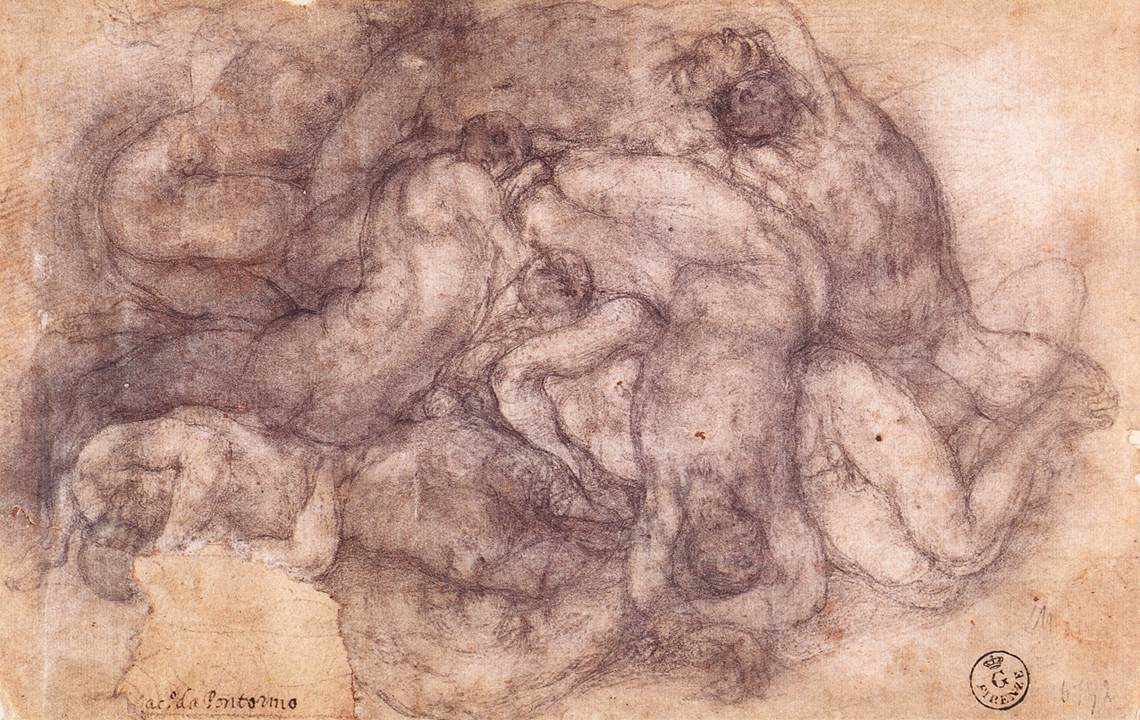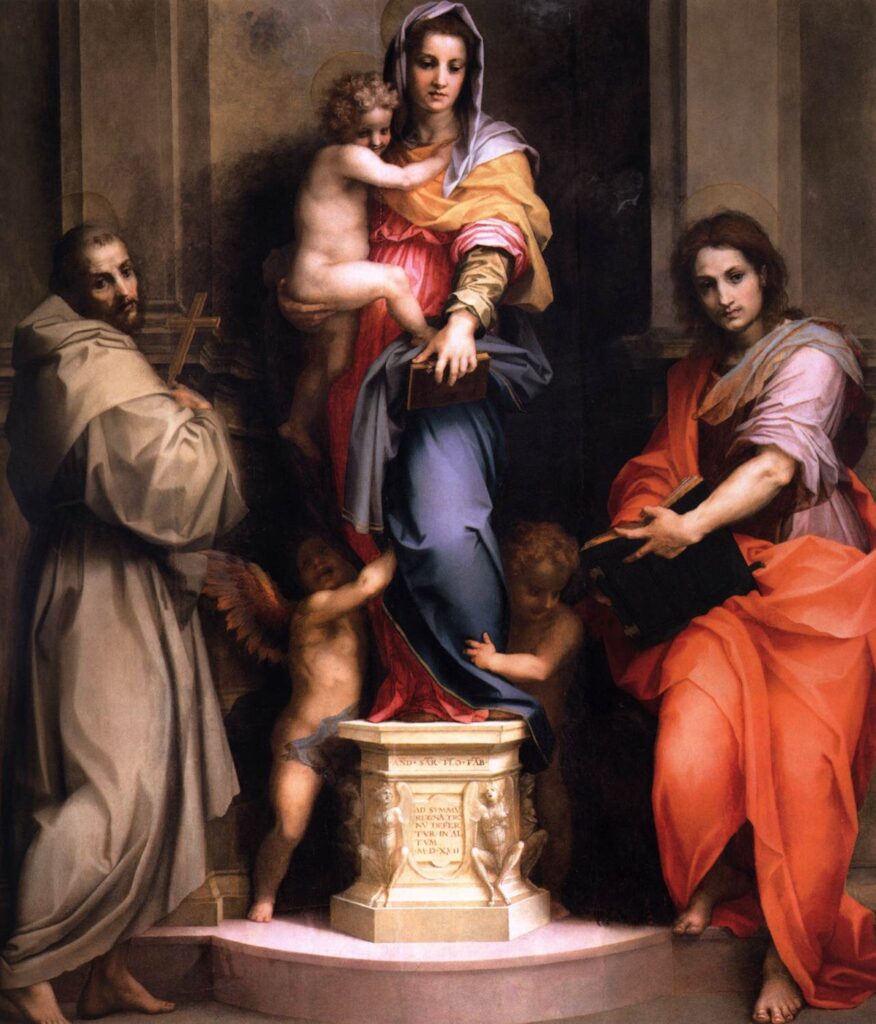If you head east from the center of Empoli in the direction of Florence and after the bridge turn left, within a few hundred meters you will find yourself at number 97/99. It is a building that can be guessed ancient from the wooden lintels embedded in the masonry. The street is called via Pontorme in memory of the time when it and a few other houses formed a suburb of the nearby city, so called because of the bridge over the Orme river (the one you just passed) but in the years we are going to talk about it was called via Pisana. Bartolomeo Carucci, a modest pupil of Domenico Ghirlandaio, had moved into that house years earlier because he had married Alessandra, the daughter of Pasquale, the owner of the property who was a shoemaker by profession. It was within those walls that on May 24, 1494 one of the strangest and most brilliant stars of the sixteenth century was born: Jacopo Carucci, later called Pontormo.
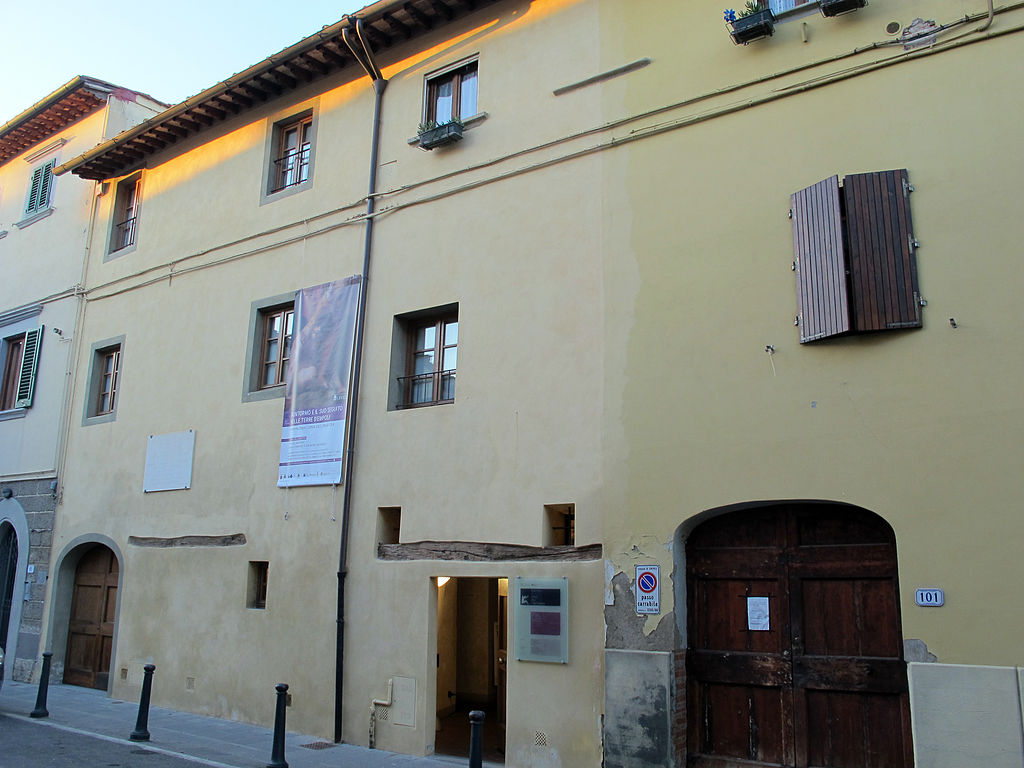
Jacopo’s childhood was marked by forced abandonment and precariousness. After losing his father at the age of six, his mother at the age of eleven and shortly afterwards his grandfather as well, it was his enlightened grandmother Brigida who took care of him and his younger sister Maddalena. At first she gave him an education that was not trivial for what remained a relatively modest family of artisans (he learned to read, write and the basics of Latin), then she sent him to Florence to live with a relative who was also a shoemaker like his grandfather and in 1508 he had the few goods he had inherited placed under the protection of the Magistrate of Pupils1. Shortly afterwards, his grandmother and sister also died and Jacopo found himself completely alone (and with these premises, it might not be surprising that Jacopo became the solitary, melancholic adult, obsessed with work and with the idea of death that Vasari handed down to us).
Again according to Vasari, it was a certain Bernardo Vettori, perhaps one of the Magistrates of the Pupils, who let him enter Leonardo’s workshop2 to exploit the talents that evidently had already manifested themselves and thus begin his career.
The real artistic career of Pontormo begins in 1514-16 3 under the refined wing of Andrea del Sarto in the Chiostrino dei Voti in front of the basilica of Santissima Annunziata in Florence, a true crucible of the Florentine “modern manner”. Together with him there is another pupil, one of his age and fellow artist who, because of his tawny hair, will be called il Rosso and of whom we will speak on another occasion.
If two future and irreducible “irregulars” such as Jacopo and Rosso entered into the orbit of Sarto after having passed through various prestigious workshops, including that of the Scuola di S. Marco of Albertinelli and Fra Bartolomeo, it must be because they perceived a vibration that was even subtly different from that of the exhausted Medici Renaissance. Del Sarto is perhaps the extreme, splendid local offshoot of a taste that by now had permanently pitched its tents in papal Rome and was transforming itself into something else under Raphael’s persuasive caresses and Michelangelo’s hammer blows. What could have attracted the two young men, besides the undisputed (and indisputable) value of the master, could have been his propensity to welcome new ideas, breaking at least in part the trite re-proposition of sedimented models still in vogue in the workshops already frequented. One of these ideas, perhaps the most important, is the acceptance of languages coming from beyond the Alps, first of all that of Albrecht Dürer. In the aforementioned Chiostrino it is noted how the wide circulation of Dürer’s engravings had already left its mark.
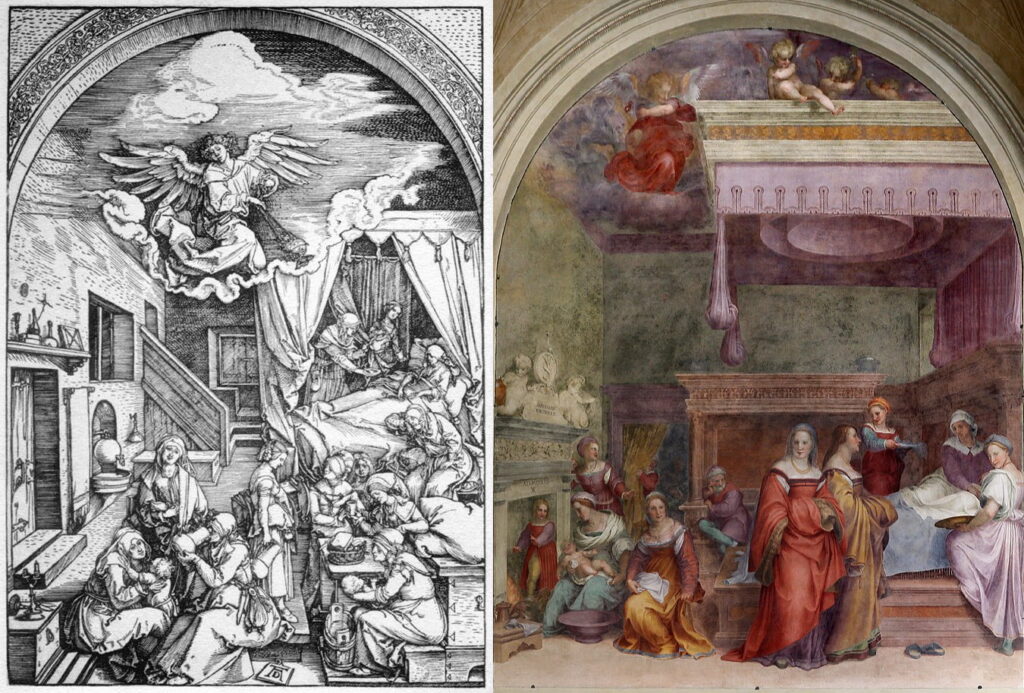
As further proof of the pervasiveness of the influence of Sartre, Jacopo’s passion for Dürer remained strong throughout the first part of his career and up to the beginning of the second, as testified by the frescoes in the Certosa del Galluzzo about ten years later.
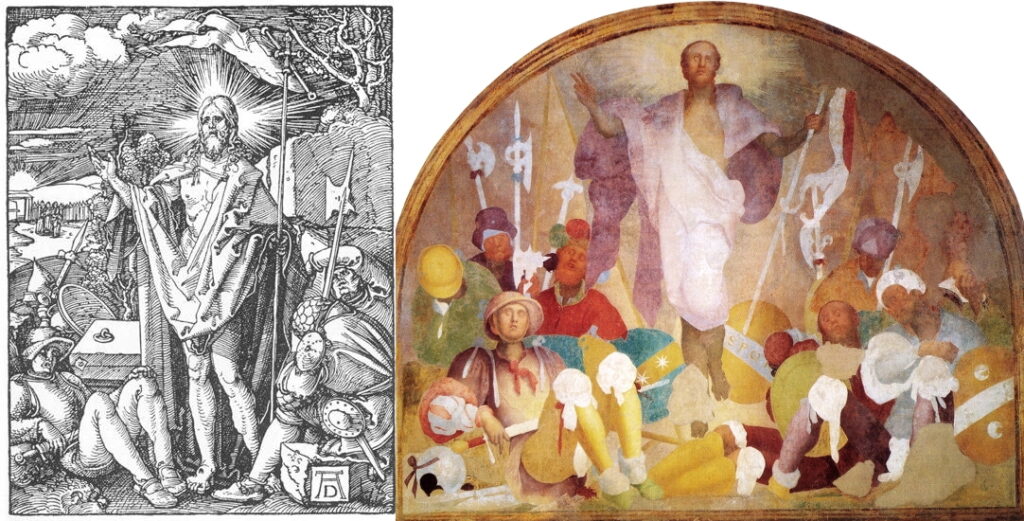
and the slightly later Supper at Emmaus (1525) in which naturalistic details that anticipate the solutions of Caravaggio and Velazquez emerge intensely
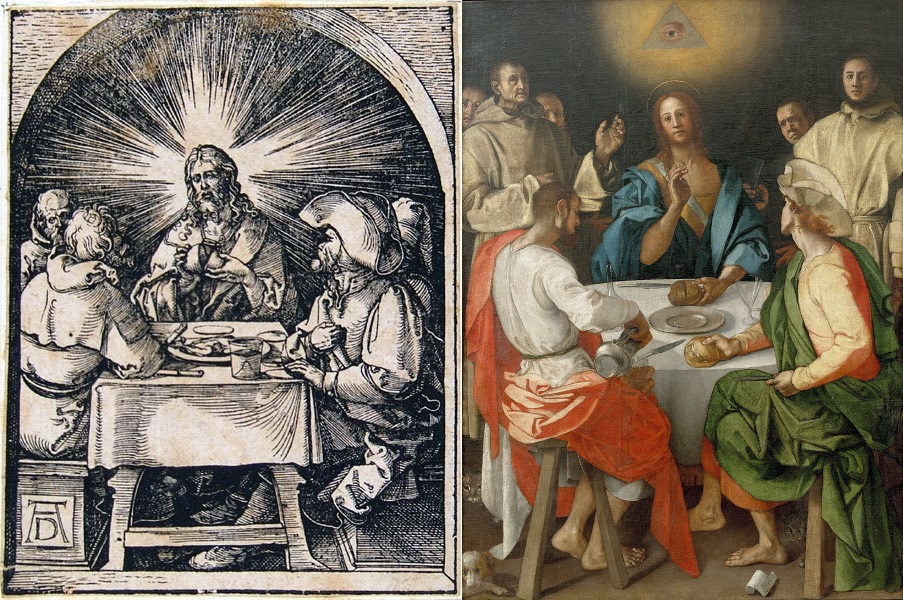
Another suggestion that crosses first the master and then the student is that of Raphael. If in 1512 Andrea del Sarto and his pupils realize the Virgin of the Girdle in Volognano, tributary of the just preceding Virgin of Foligno,
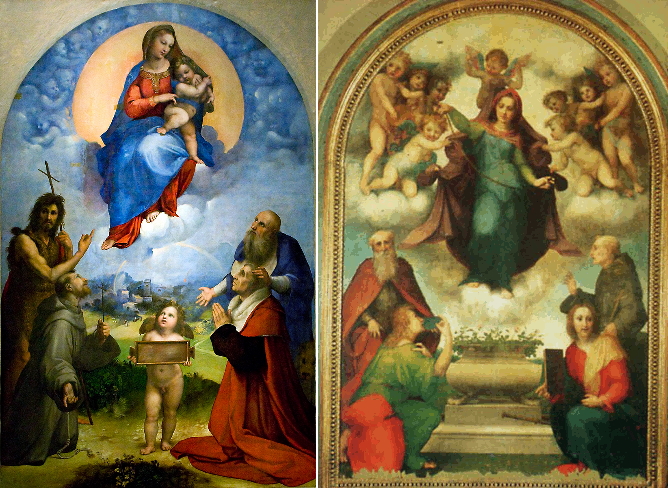
in 1514-16 Pontormo paints a splendid Visitation that, even if it shows echoes of the past frequentation with Fra Bartolomeo4, show ties to a first-hand knowledge of the Stanza della Segnatura5.
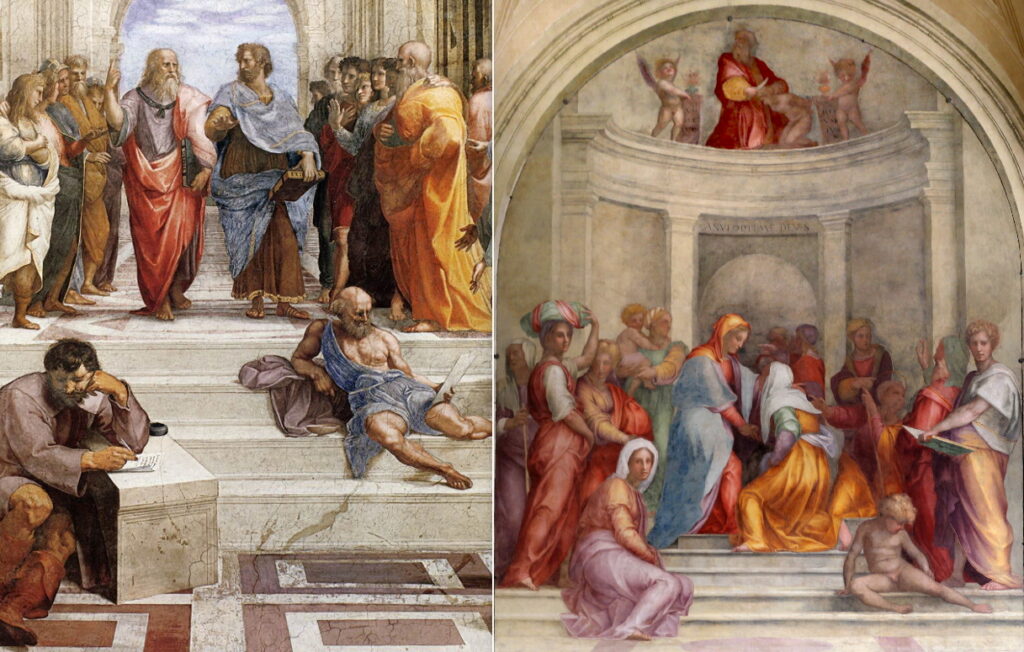
Up to this point, the young Pontormo remained in his master’s wake, but only two years later we already find him on another path. In 1517-18, while Andrea del Sarto painted the splendid Madonna of the Harpies, Jacopo produced the Pucci altarpiece. While the first one is hyperclassical, composed, symmetrical and sorrowful, the second appears untied and exploded with the figures arranged on two parallel diagonals in a precarious balance against an unexpectedly dark background cut by a grazing light at the level of the characters. The pyramidal scheme is not completely rejected, but the links between the figures, sanctioned by tradition and apparently irremovable, are cut like a Gordian knot and new ones are established
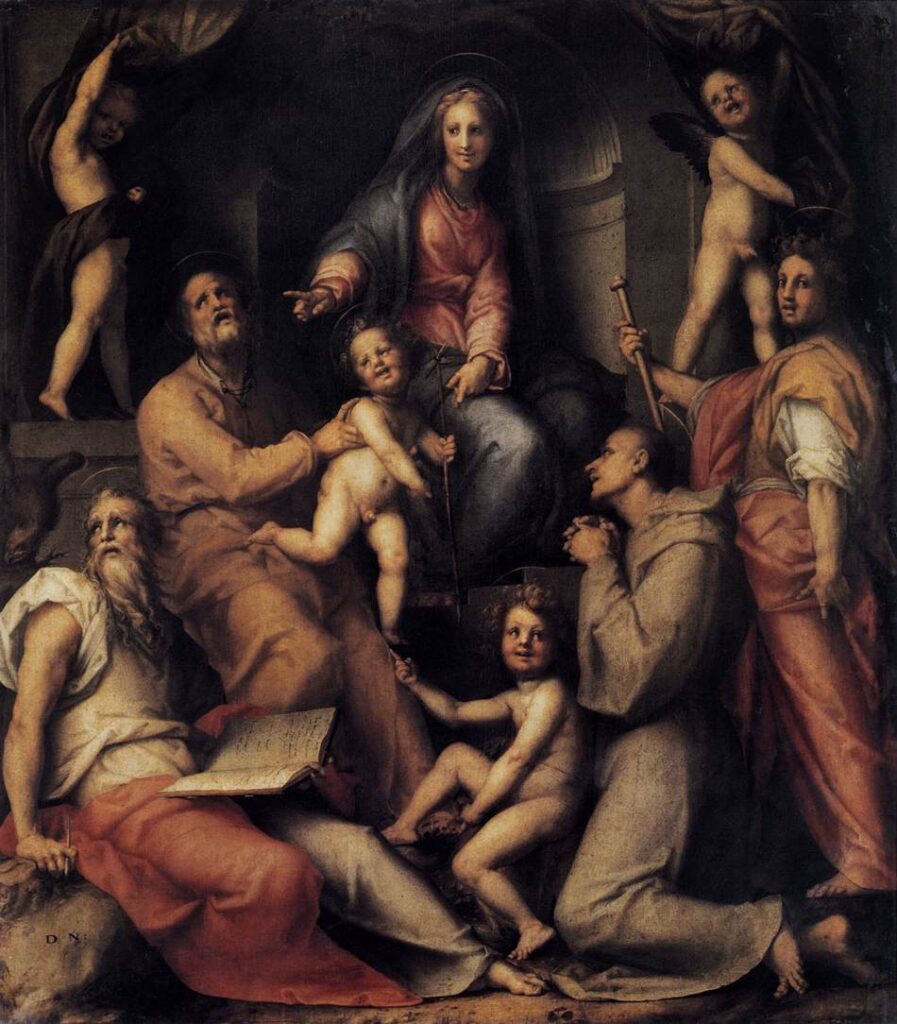
A bit earlier, the panels for the Borgherini Wedding Room, among which Joseph in Egypt stands out, an equally innovative masterpiece that has a Nordic landscape taken from Dürer or Altdorfer as its background6 and upsets the measured composure of tradition with a polycentric tale, a staging borrowed from the medieval tradition of representing different moments of a temporal sequence in the same space, each of which feeds others in a cascade in a whirlwind of events and characters.
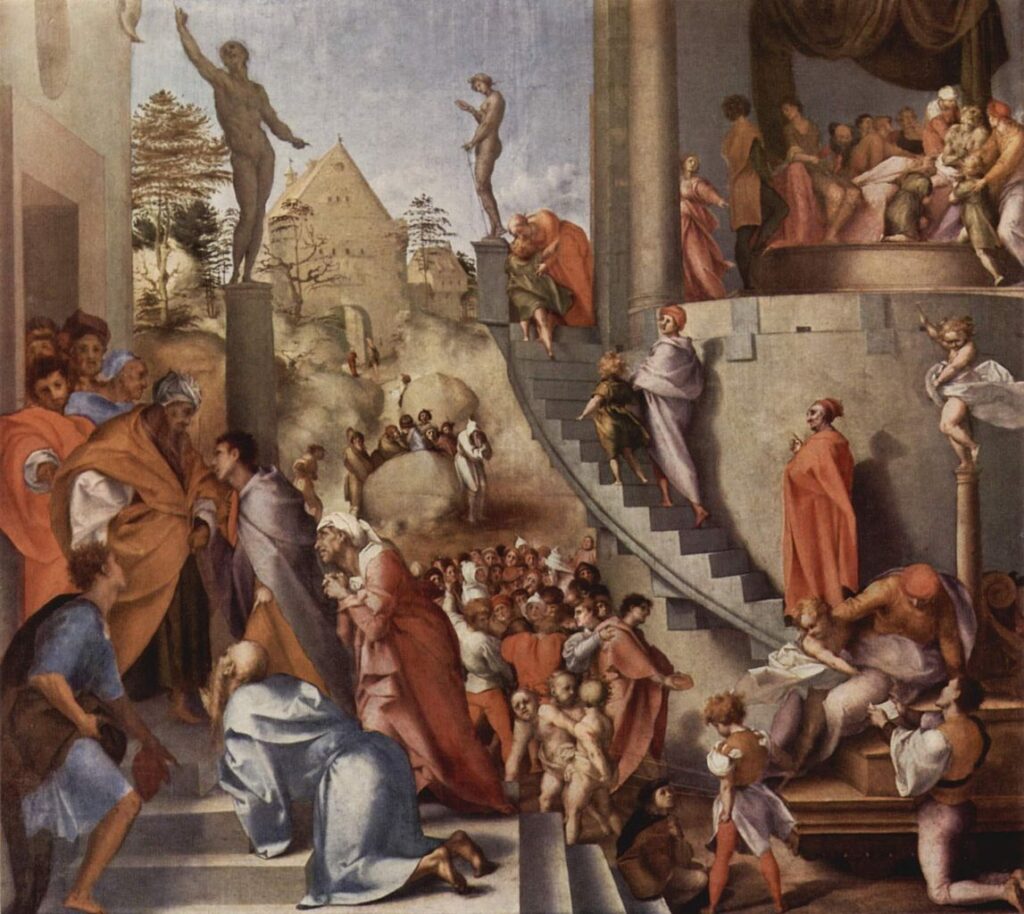
It is here that Jacopo’s path (like Rosso’s, although declined differently) begins to diverge from the Renaissance charis and to declare his anti-classical riot, the real root of Florentine Mannerism. Pontormo gets off the train of the composed serenity of Raphael’s classicism and of the glossy softness of Vinci to embrace Dürer’s edgy expressionism at first and later the twists and the explosive colorism of Michelangelo’s body masses7 but he does it in such a personal way that he manages to escape the enormous gravity force exerted by the models and build a unique style.
This is also the point at which Vasari, in his Lives, begins to target him and more than openly manifest (up to the border of the insult) his displeasure with the “german manner” undertaken by Jacopo, but we will discuss this later in a broader context.
This was followed by years of very intensive study, as witnessed by the amount of sketches and drawings8, resulting in a series of masterpieces.
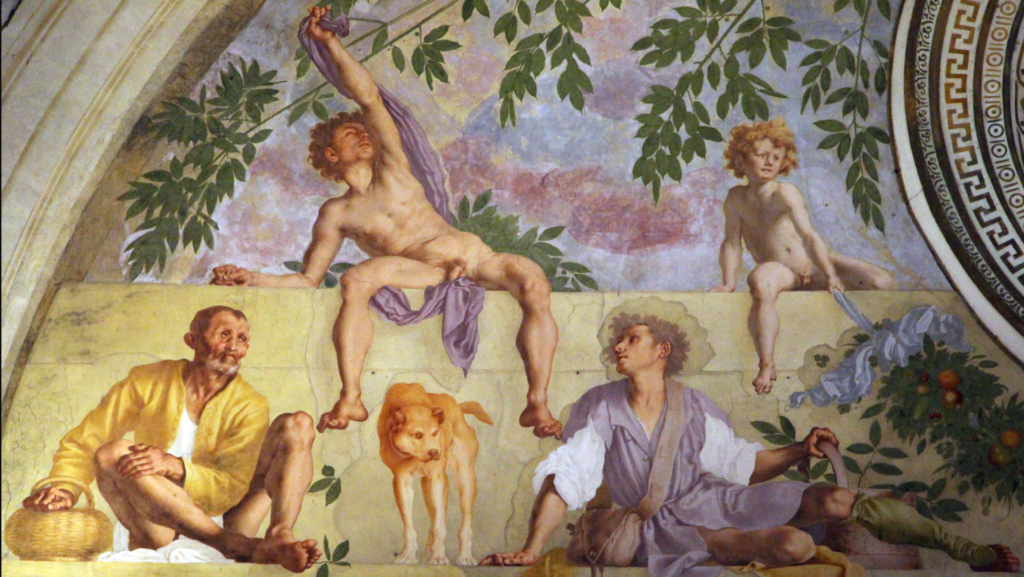
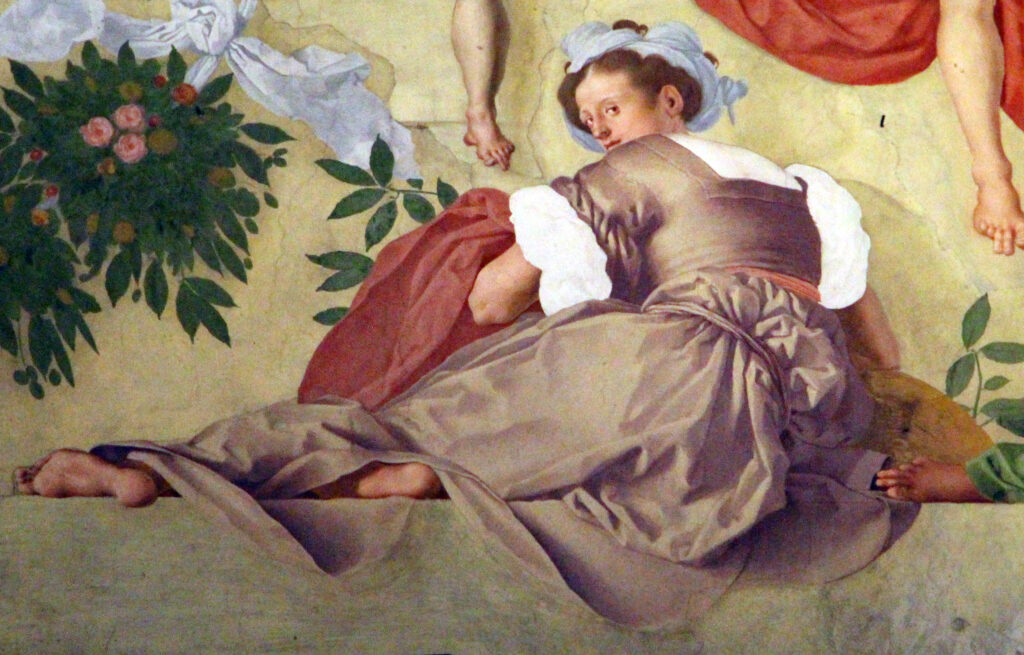
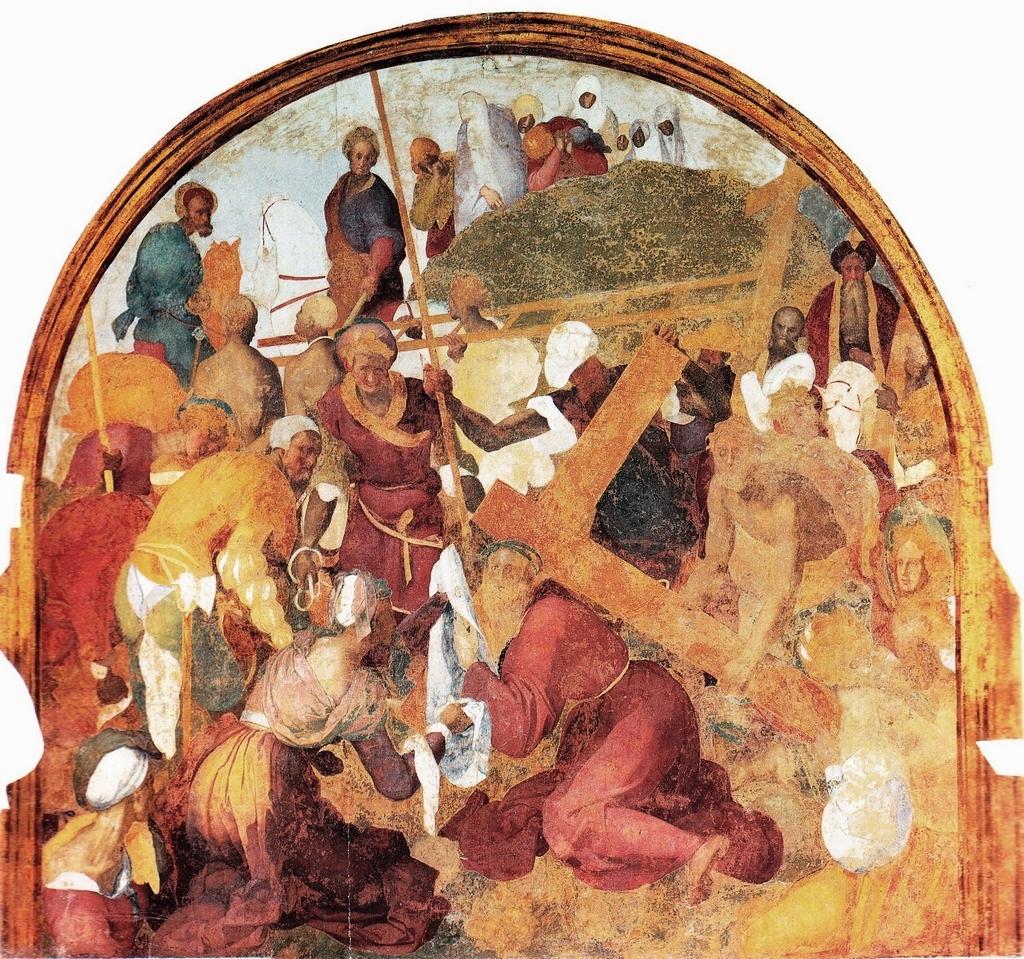
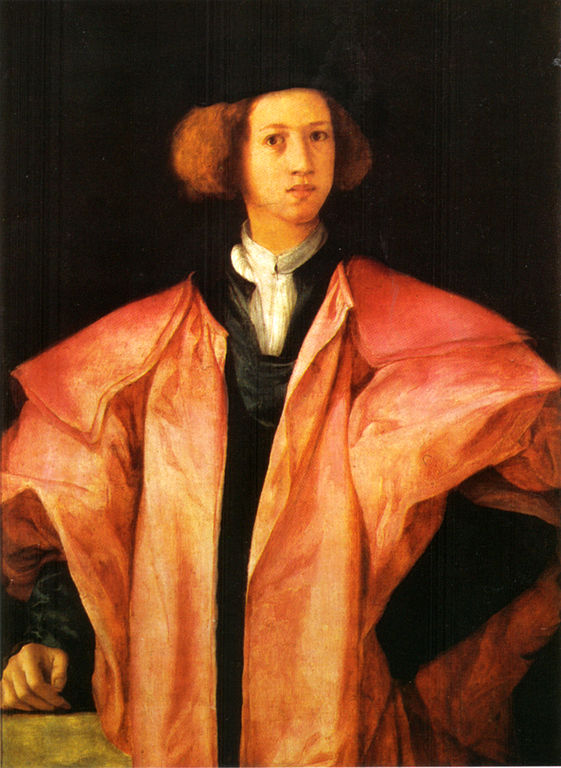
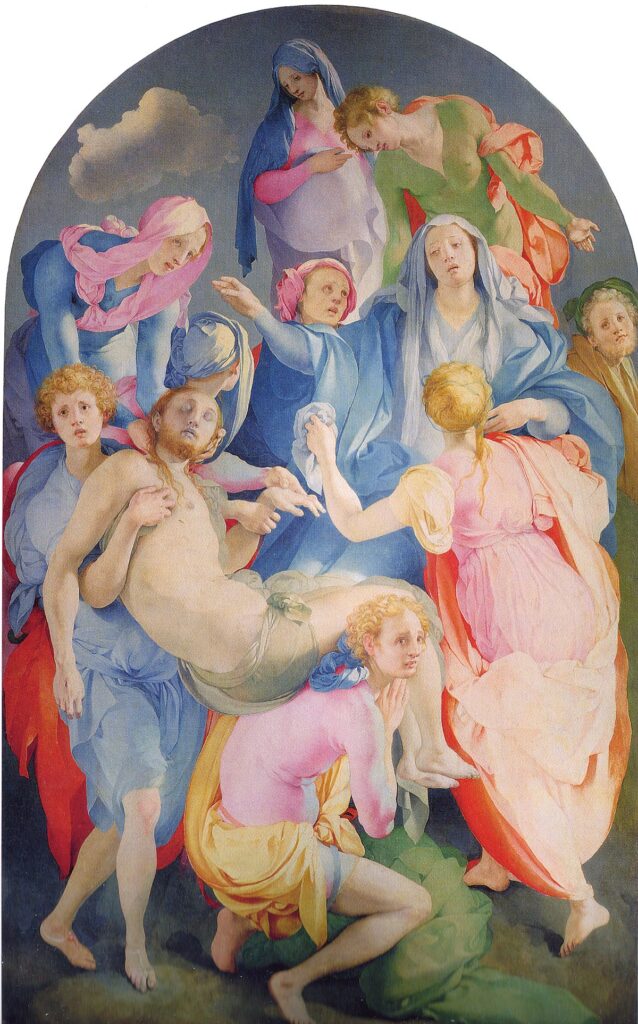
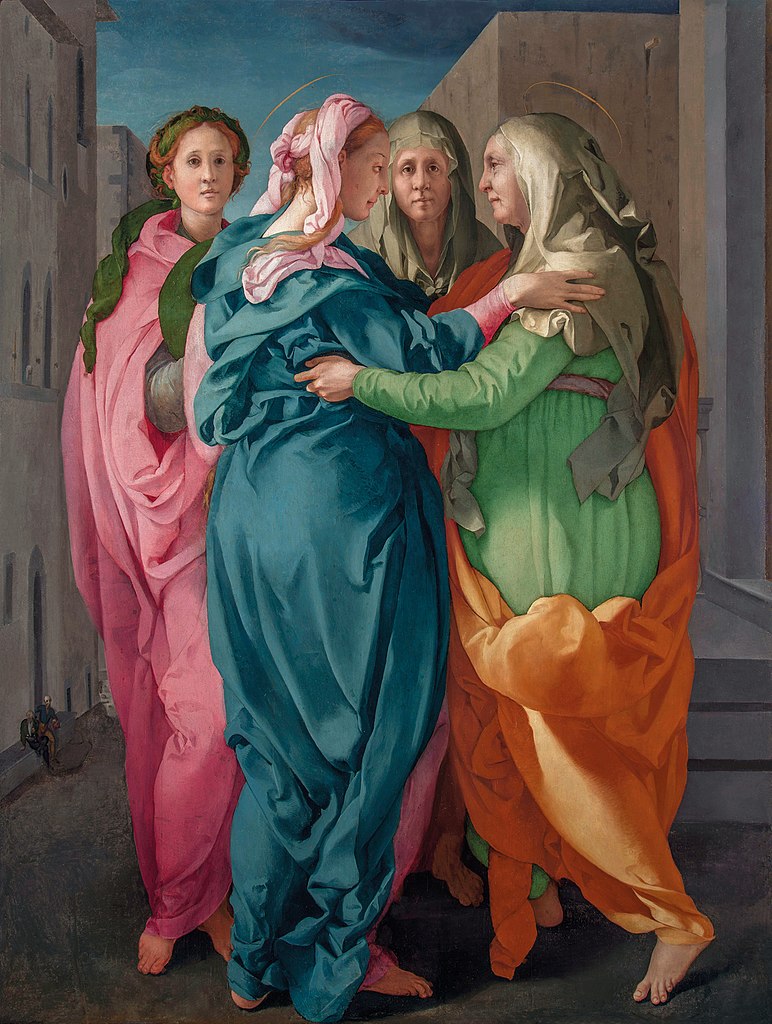
It was in these years, and especially in the second half of the ’20s, that the style of the mature Pontormo emerged strongly, made up of a clear and harsh renunciation of perspective (one of the most characteristic achievements of the Florentine Renaissance), acid and bright coloring, marked emotional and expressive charge alternating with cold ambiguity and “hallucinated lightness” (primary sources of inspiration for the future chilling Medici portraits by Bronzino). The figures elongate or swell in forms of a bizarre and refined elegance, sometimes compressed in a metaphysical space as in the Carmignano Deposition and sometimes swirling in a vortex that seems suspended in nothingness as in Santa Felicita.
At the end of this creative vortex, that coincides more or less with the last years ’20s, begins the last phase of Jacopo’s career characterized by a hand-to-hand combat with Michelangelo’s art. The restless and uncontentious Jacopo forces the new frontier on which he had just settled and, once again, he goes beyond.
The premonitions are clearly visible in the Ten thousand martyrs in which the funeral statue of Giuliano de’ Medici Duke of Nemours resounds in the figure of the seated emperor and the Battle of Cascina (as well as Leonardo’s Battle of Anghiari) in the clash on the left.
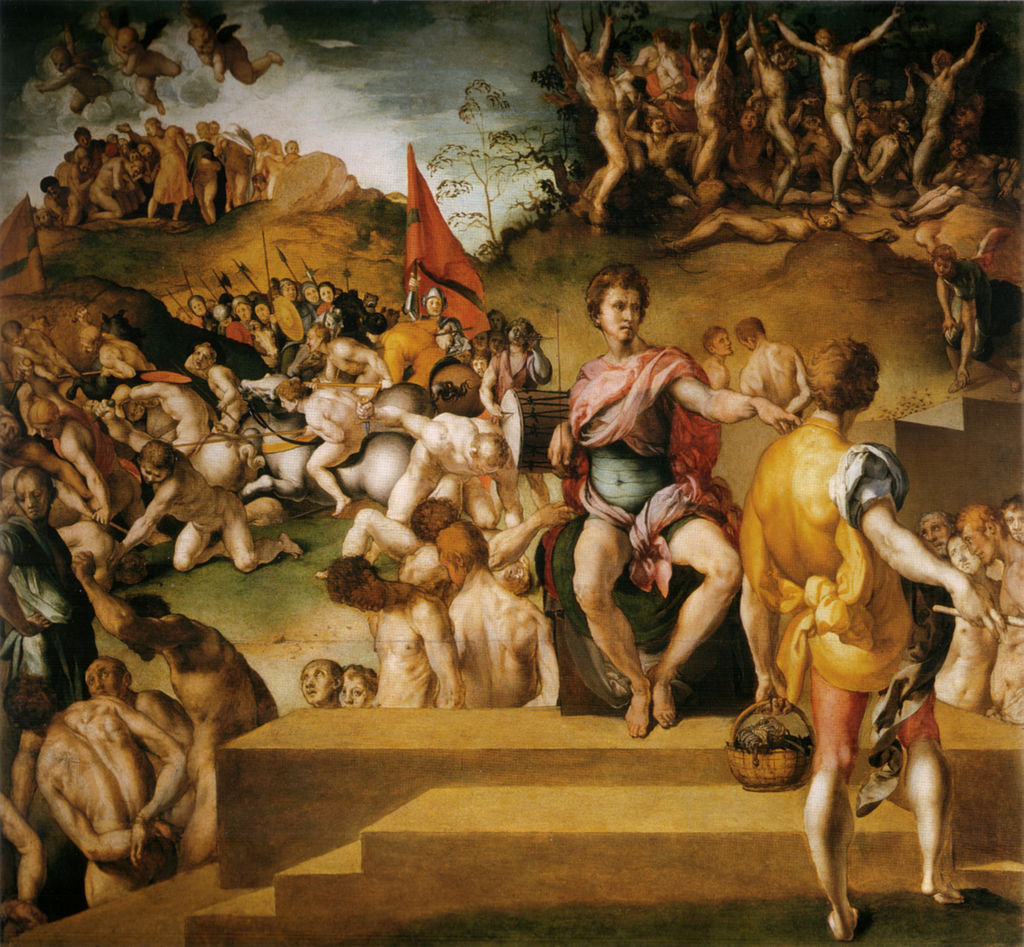
About a year later Alfonso d’Avalos, Marquis of Vasto, commissioned Michelangelo a drawing to be made into a painting on the theme of Noli me tangere. The painting had to be a homage for his aunt Vittoria Colonna9 and it was Buonarroti himself to recommend Pontormo as executor “because nobody could serve him better“.
The result of this combination of Michelangelo’s drawing and Pontormo’s colorism is a dark and intense work that was much appreciated at the time (with several requests for replicas) and whose only publicly available version is the copy painted shortly thereafter by Bronzino and preserved at Casa Buonarroti10.
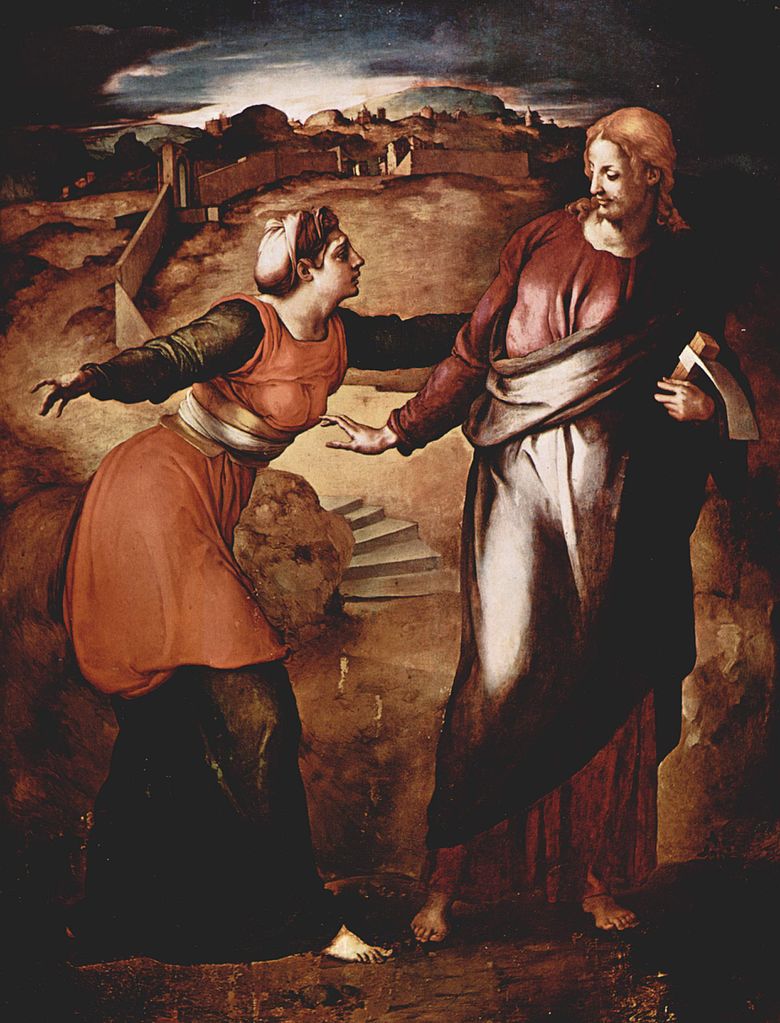
Slightly later we have a sort of “twin” work: the Venus and Cupid painted on the basis of a drawing commissioned to Michelangelo by his friend Bartolomeo Bettini11.
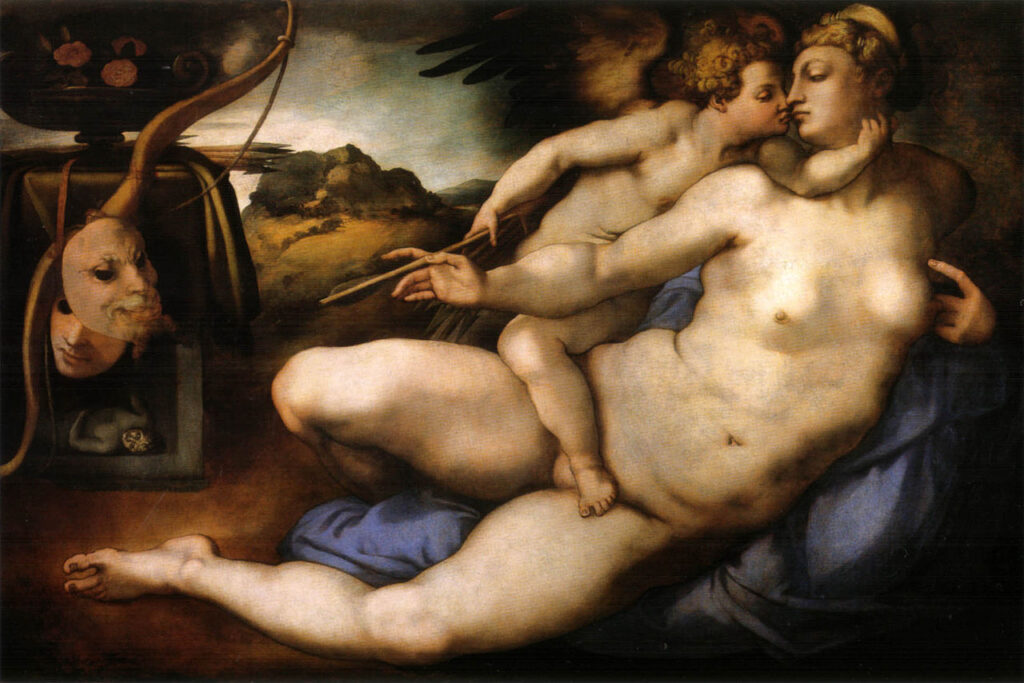
According to Buonarroti’s tradition, Venus is as androgynous and ambiguous as ever12. The unnatural twisting of the figures and the symbolic density make this a magnificent anticipation of the rising tide of the Mannerist style, in which it is difficult not to see a prodrome of Venus, Cupid, Folly and Time painted by Bronzino ten years later for Cosimo I de’ Medici13.
The dialogue with Michelangelo continues with Mary, Christ and the young John the Baptist whose powerful anatomy seems to refer partly to the Sistine Chapel Sibyls and partly to the Doni Tondo.
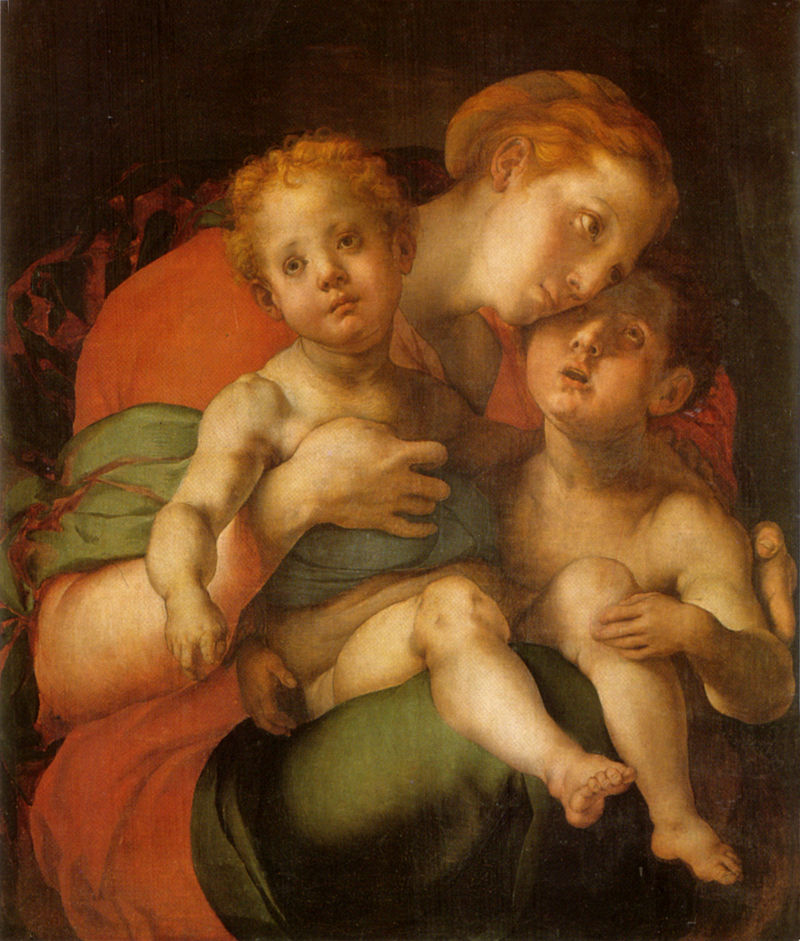
In 1537 the new Duke of Florence Cosimo (later Grand Duke of Tuscany) commissioned him the decoration of the main loggia of the Villa di Castello, home of his mother Maria Salviati. The complex iconographic plan prepared by the ducal astrologer Giuliano Ristori included the allegorical representation of Cosimo’s horoscope14 plus Liberal Arts and mythological figures.
Jacopo, in exchange for eight scudi a month, performed his usual turata, the total closure to view of the spaces to be painted by means of drapes and scaffolding, and locked himself away for five years, grappling with his experimental technique of oil on dry lime which had already given a bad test in the villa of Careggi.
The frescoes have been lost but to testify the impact remains the harsh description of Vasari: “He made a Saturn in the middle of the vault with the symbol of Capricorn and hermaphrodite Mars in the symbol of Leo and the Virgin et some cupids in the air that fly like those of Careggi. He made then as some huge women, and almost all naked, Philosophy, Astrology, Geometry, Music, Arithmetic and a Ceres […] the proportion of the figures seems very unequal, and some distortions and attitudes seem to be without measure and very strange“.
Another aspect not calculated by Jacopo was the bad character of the lady who one day, irritated by not being able to observe the frescoes and definitely not used to being denied, ordered to pull down all the covers so that she could see what Pontormo was working on. What she saw was Michelangelo’s physicality transposed, with an extreme recklessness, in an unknown territory, bloodless, mortal and stripped of any possible heroism.
To testify it, besides Vasari, there are some preparatory drawings that in case of a more than unusual Mars is difficult to look at without thinking of the emaciated and tormented bodies of Schiele
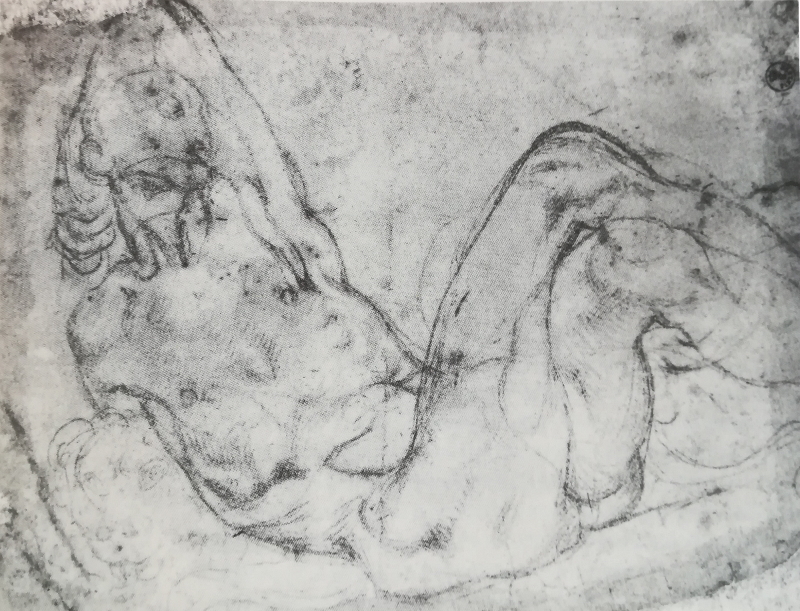
or, in the case of Mercury, of Matisse.
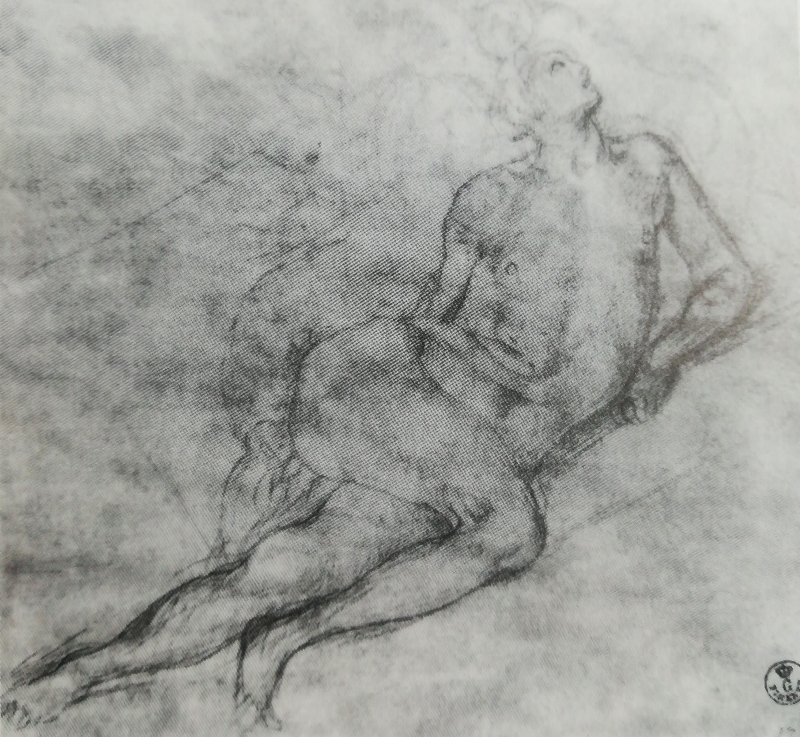
Jacopo comes out badly from the flop at the villa di Castello. His usual melancholy and hypochondria are further accentuated by the refusal of his work by Maria Salviati, by the breakdown of his relationship with Michelangelo, by the growing distrust of his circle, which tended to be pro-republican, in the face of his efforts to please the Medici and the sudden rise of his former pupil and friend Agnolo Bronzino, the bearer of a less extreme style that was rapidly making inroads into the Medici court, perhaps already in search of more glossy and tranquilizing mediums to promote their fortunes. Bronzino, although bound to Pontormo by an almost filial relationship of affection that was to last a lifetime, belonged to an entirely different human type: Educated, extroverted, elegant and willing to satisfy the Duke’s desire for representation, even in territories in which Pontormo had never ventured except in the now distant role of a student of Pontormo’s workshop, such as the staging of festivals, comedies and other ephemeral decorations, Bronzino seemed to be the plastic representation of the new “organic intellectual”, a position in which the slightly younger Vasari and various members of the Accademia degli Umidi (later Accademia Fiorentina) would soon be mirrored. The contrast with the wild and distrustful Pontormo could not have been more evident and yet it was in that circle that he had his few friends, such as Bronzino himself, Benedetto Varchi, Luca Martini, Vincenzo Borghini, Pierfrancesco Riccio, Giovanni della Casa and Giovambattista del Tasso (people whom he frequented regularly, a demonstration that when Vasari speaks of a solitary attitude at times bordering on misanthropy his judgement is not entirely serene and we’ll learn the reasons later).
Despite the fact that the frescoes of Castello did not receive the approval he had hoped for, in 1545 Pontormo obtained a new commission from the Medici court: the realization of the cartoons for some tapestries destined to the Sala dei Duecento in Palazzo Vecchio and today conserved at the Quirinale. Under the supervision of the aforementioned Pierfrancesco Riccio, the Duke’s “butler” (i.e. factotum), sixteen of the twenty cartoons (in addition to the grotesque borders of the entire cycle) were entrusted to Bronzino, three to Pontormo and one to Francesco “Cecchino” Salviati. The theme of the tapestries are the stories of Joseph, with whom it seems the Duke loved to identify. So Jacopo, almost thirty years after the Borgherini room, finds himself dealing with the same theme, but once again his stoic faithfulness to a very personal style does not satisfy either the Duke or the Flemish tapestry makers Janni Rost and Nicholas Karcher, purposely brought to Florence, tapestry makers who, according to Vasari, complained about the difficulty of realization imposed by the strange shapes designed by Pontormo:
“neither the Duke nor those masters had to weave them did like them, as they thought they were odd and that they could not be made into woven fabrics“.
Personally, even though I know nothing about tapestries and weaving, I wonder what kind of difficulty it might have caused very skilled artisans to create some forms rather than others (especially when compared to the intricate and detailed grotesques by Bronzino in which they are framed) but perhaps we are faced with further evidence that Vasari wants to create to support his judgment.
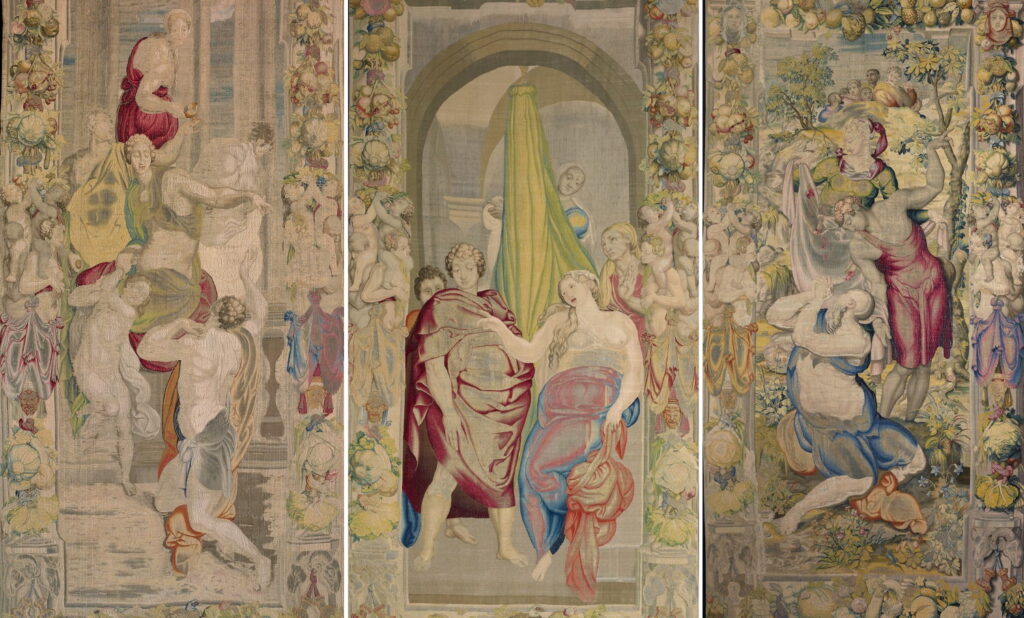
The tapestries were realized in spite of their partial divergence from the Duke’s expectations and Jacopo’s rapid loss of interest due to what appeared to be the most prestigious commission he had ever received and which would keep him busy for the last eleven years of his life: the fresco decoration of the choir in the Basilica of San Lorenzo.
San Lorenzo was not just any church: when it was completely rebuilt in the 1420s, it already had a millennium of history behind it as an early Christian basilica, and for about a century it had been the de facto the church of the Medici family and the mausoleum deputed to preserve their memory. It was precisely the great prestige deriving from this assignment that triggered a real war between gangs within the intellectual elite that thrived in the shadow of Cosimo I.
The official version of the event is, as usual, the work of Vasari, who does not spare punches while attributing them to unfounded gossip: “And because His Excellency […] decided to paint all the main chapel of the magnificent temple of San Lorenzo, already built by the great Cosimo Vecchio de ‘Medici. And so, having given the task to Iacopo Puntormo, either of his own accord or through Messer Pierfrancesco Ricci maiorduomo 15 […]. Some say that seeing Iacopo having been assigned that work, despite the fact that Francesco Salviati, painter of great reputation, was in Florence and had happily managed and painted the hall of the palace, where the audience of the Signoria was, he said that it would show how to draw and paint, and how to work in fresco and, beyond that, that the other painters were nothing but cheap people and other similar lofty and insolent words. […] I believe that these things were appropriate for him and that he never let such boasting come out of his mouth, which are mostly things of vain men who presume too much about themselves […]. And even though I could have kept these things quiet, I did not want to do it […] nevertheless I have the firm opinion that they were the words of evil men“.
In short, it was rumored that Jacopo had “stolen” the commission from Salviati through obscure maneuvers of the palace and that, not being enough, he went around boasting about it.
Francesco Salviati16, known as Cecchino, was not an easy man: talented, ambitious, notoriously ill-tempered and sharp-tongued, he was sixteen years younger than his rival and, like him, had attended the workshop of Andrea del Sarto as a boy. Florentine by birth, he had left for Rome in 1531 with a reference for Card. Salviati. Returned to Florence in 154317, he had immediately distinguished himself, as Vasari recalls, in the decoration of the Sala dell’Udienza [Audience Hall] of Palazzo Vecchio with his Stories of Furio Camillo, whimsical synthesis of Raphaelism and Michelangiolism enriched with those effects and inventions that will contribute to create the character of the maniera.
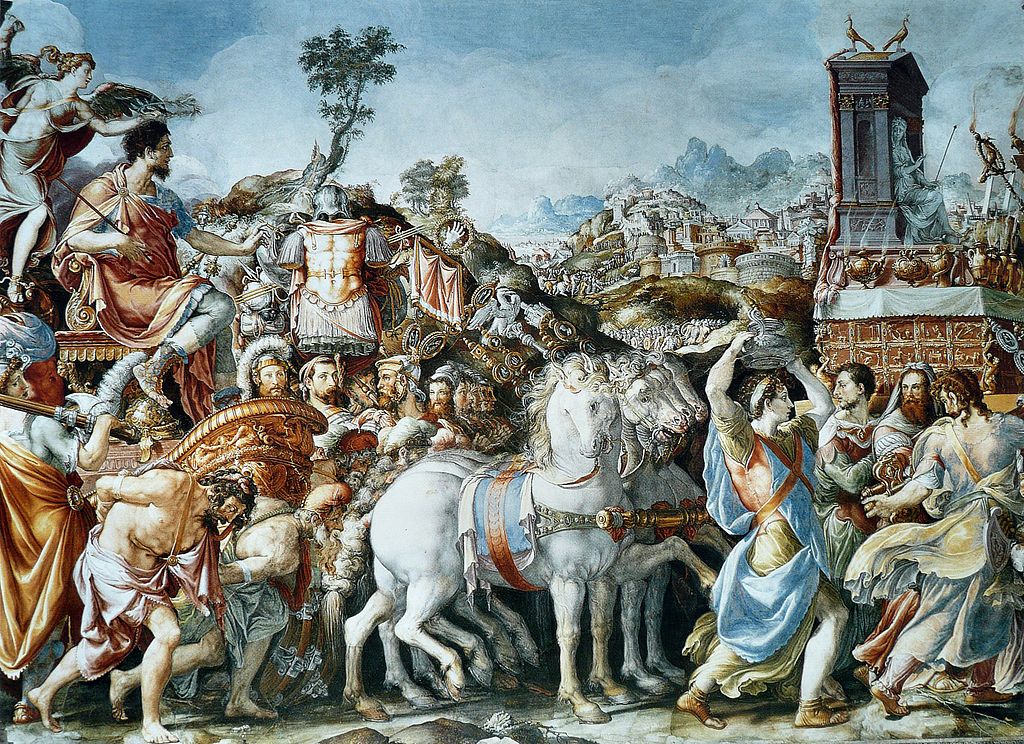
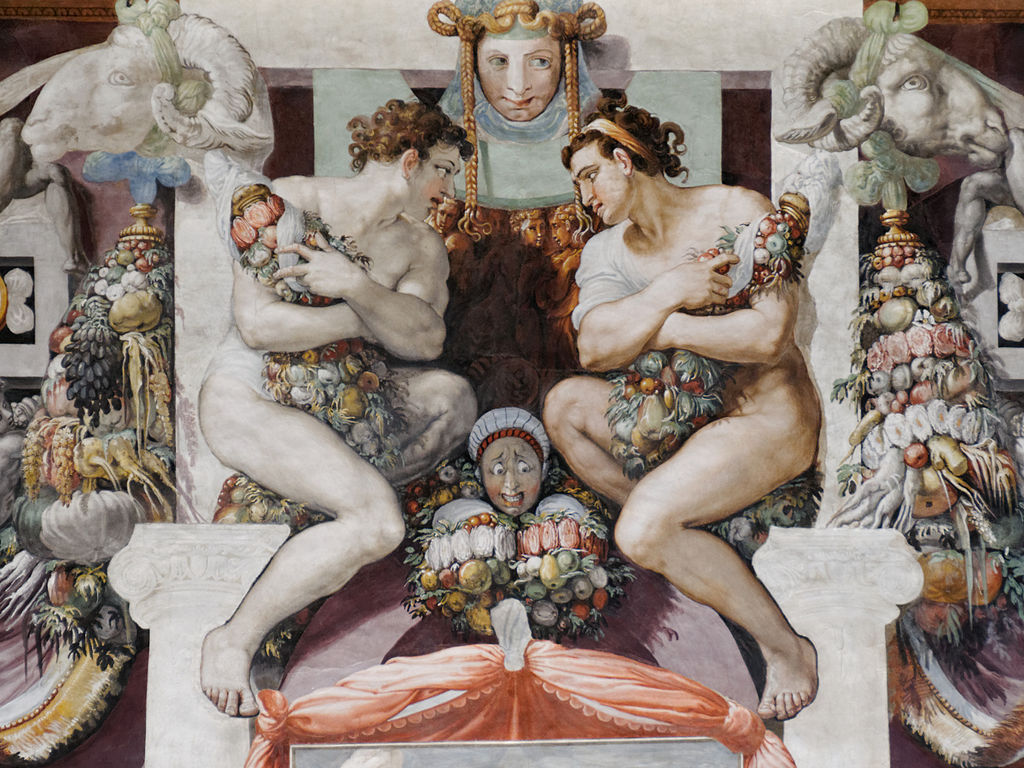
But Salviati’s chances were not all in his pictorial ability (as well as his speed of execution, something that certainly could not be said of Pontormo). Friend of Vasari since his adolescence, on his return to Florence he had made a big effort to get in good with the Medici cultural entourage, succeeding in making a breach with his elegant eclecticism and hypercitationism in the preferences of the powerful Riccio and Tasso.
When the commission for San Lorenzo looms on the horizon, Salviati assumes that his skills will make him win the race with Pontormo but shortly after his restless character leads him to a fatal mistake: in an excess of confidence he seriously disrespects Del Tasso, one of the most influential figures of the court, and his position plummets at the same rate at which it had risen:
“When he had then taken, according to what they say, practice of the court and seemed to him to be in favor, returning to his quick-tempered, biting nature, he had no respect for them; On the contrary, he used to criticize and blame the works of the others with very mordacious words, as he used to do (which served as an excuse for his adversaries), and he put himself and his works above the stars. These manners, displeasing to most people and also to certain artists, gained him so much hatred that Tasso and many others who had become his friends, began to put him in trouble“
When, shortly after, the entrusting of the frescoes to Pontormo becomes public knowledge, Francesco understands that for him in Florence the game is done and resolves to leave for Rome. In a long letter full of grudge addressed to his lifelong friend Vasari, he complains about a sort of conspiracy hatched against him by Riccio and Tasso so that his projects, contrary to the gossip, would not come to the attention of the Duke, thus making him prefer those of Jacopo, a hypothesis that Vasari will not scruple to feed in his Lives.
At this point, we need to discuss an aspect that is not entirely minor (especially considering the bitter fruits it will end up producing) and that has often been hinted at up to this point, perhaps raising a few eyebrows in surprise, but not explained: why does Vasari have it in for Pontormo?

There are probably three reasons for this, in addition to the above-mentioned question of the quarrel, however circumstantial, with his friend Salviati: one is strictly personal, one is purely stylistic and one is a matter of political opportunity. Keeping in mind that they are not always easy to separate from each other, we can try to describe them briefly.
For the first one, the personal one, we must keep in mind two factors: that Pontormo appears only in the second edition of the Lives, the one of 1568, and that Vasari in the years we are talking about is not in Florence. In fact, in 1547 he had not been in Florence for ten years, during which he had also served the Farnese family of Paul III and his nephew Card. Alessandro, the most bitter enemies of the Medici. The first version of the Lives, essentially finished in ’47 but published only in ’50, starts with a dedication to Cosimo I aiming to ingratiate him in view of a return to the city, but his project will be hindered in all probability by the academics who populated the court of the Duke and who must have discouraged him to bring back home an element that until recently had been in the service of the enemy. Those who opposed his return, which took place only in 1554, were about the same ones who so often dined with Jacopo and advocated his candidacy for prestigious commissions. Therefore, it is not surprising that Vasari, in the revised and enlarged edition of 1568, i.e. when he was firmly established in the good graces of Cosimo, deliberately wanted to settle some unfinished business by striking the memory of Pontormo as a part, and even more a symbol, of that circle that had long opposed him.
I believe that the visceral dislike of the sociable, cultured and well-connected Vasari also played a role, as he was all set to support and promote the sprezzatura, true leitmotiv of those decades, with regard to Jacopo’s humble and fiercely introverted nature (as well as his decidedly slow operating method compared to the standards of the time). Evidently in his heart there was room for only one saturnine temperament and that was that of Michelangelo18.
The second reason, which we will define as stylistic, stands out dramatically in Jacopo’s life when it’s essentially described as an ascending phase followed by an inexorable descending parabola in a clash that cannot fail to be jarring with today’s evaluation of Pontormo as one of the peaks of the sixteenth century. To trigger this denigrating mechanism is one of Jacopo’s main characteristics, his inexhaustible experimental restlessness which the much more appeasing and adaptable Vasari, slave of his academic common sense, does not hesitate to define as “overdoing and almost straining nature”. Perhaps the clearest evidence of this attitude can be found in the difference in treatment between the Pucci altarpiece and the Deposition of Santa Felicita. If, in fact, he dedicates to the former, even though it is a seminal and important work, a high praise that sounds quite out of place (“Iacopo conducted that work with such a beautiful manner and with such a lively coloring, that it seems almost impossible to believe it. […] so it is no wonder if this is the most beautiful table that he ever made“) to the second one, true masterpiece of the following years, he devotes words of a disconcerting coldness (“in the said chapel, it seemed almost that he came back to his first way, but he didn’t follow the same in making the table, so that, thinking about new things, he made it without shadows and with a clear and so unified coloring, that you can hardly know the light from the half-light and the half-light from the dark“). In general, throughout his biography, it is easy to find signs of this escalation of disapproval which, although at times punctuated by mildly positive evaluations, culminates on the one hand with the suggestion of a mental state compromised by his long practice with that morbid and melancholy desire to overdo (“he troubled his brain spoiling and remaking today what he had done yesterday“) and on the other with the terrible criticism of the frescoes of San Lorenzo.
The third reason is intimately linked to the nature of the frescoes and we will postpone it until later when we will have some more elements to evaluate it.
In those years Florence was the object of a massive campaign of aesthetic projects aimed at celebrating Cosimo and creating consensus around his figure. Bronzino, Cellini, Salviati, Vasari immortalized him as Noah, Hercules, Moses, Camillus, Jupiter on the basis of iconographic programs drawn up by the intellectuals of the court such as Vincenzo Borghini, Cosimo Bartoli and Benedetto Varchi, and it can be taken for granted that the program of the frescoes for the choir always came from that circle (with a probable prominence of Varchi)19.
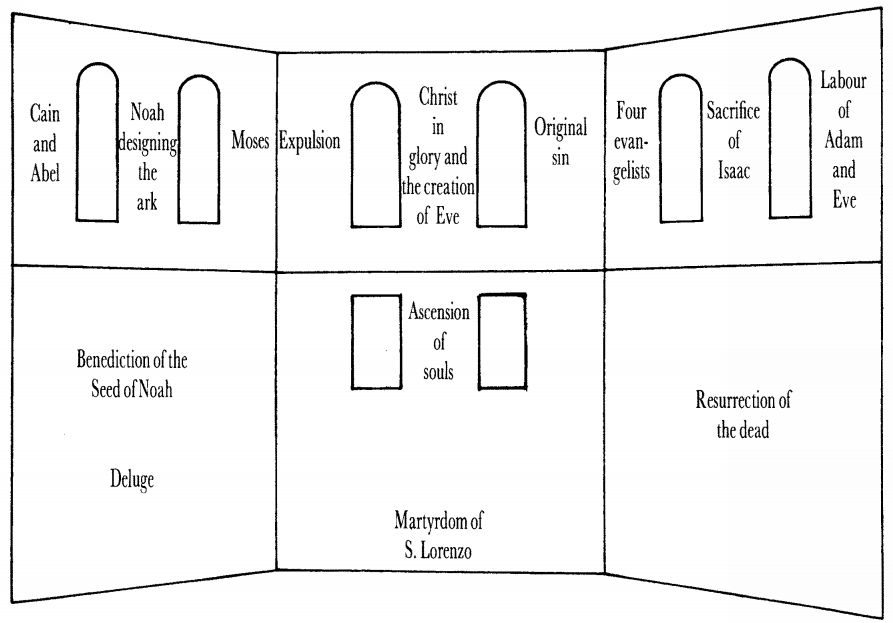
Apart from Vasari, the literary sources available to us for a reconstruction of the general layout consist of a series of chronicles and memoirs written over the period of about two centuries between the creation of the frescoes and their destruction (Borghini, Lapini, Galletti, Bocchi, Del Migliore, Cinelli, Cirri, Richa). From the graphic point of view, besides the large number of sketches made by the author, the study of de Tolnay was very useful. In 1950 he crossed the literary data with a rare engraving preserved at the Albertina of Vienna depicting the church as it was on November 10, 1598 during the funeral mass for the death of Philip II, an engraving that reproduces part of the walls of the choir with the frescoes.
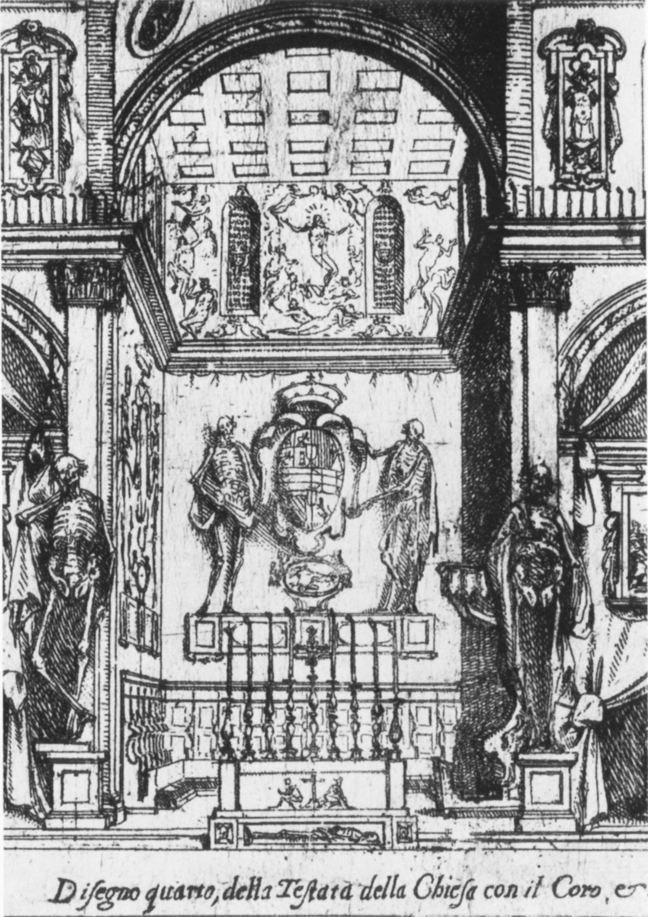
Thankfully, from the preparatory drawings we can get a pretty good idea of what Pontormo had painted (I apologize for the quality of some of the images but with the means at my disposal I couldn’t find anything better).
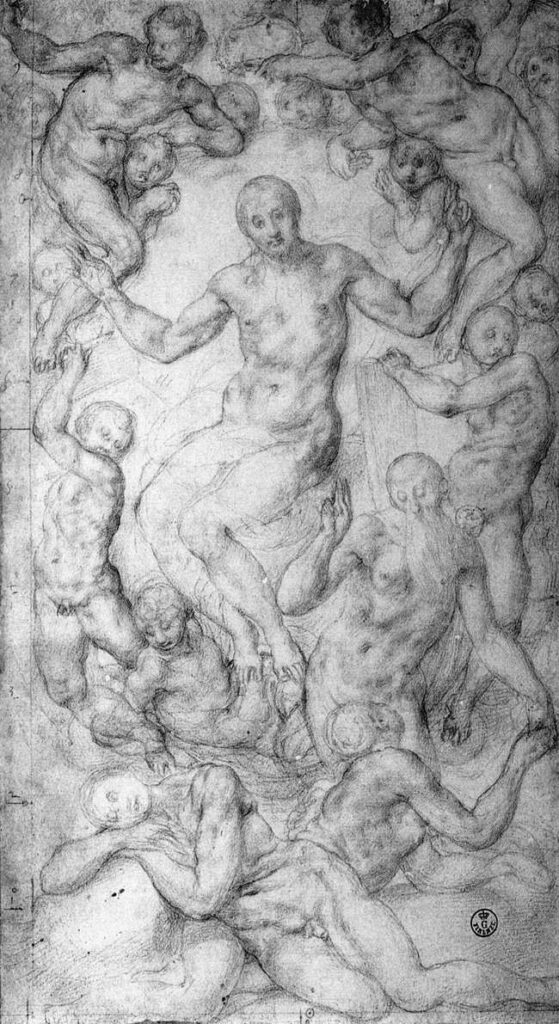
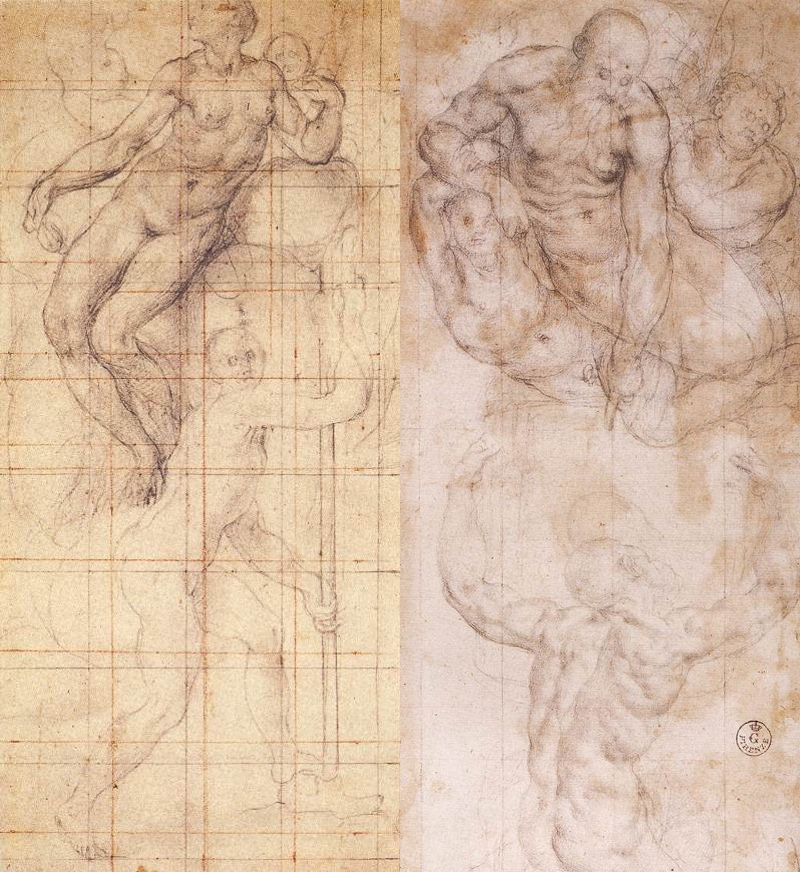
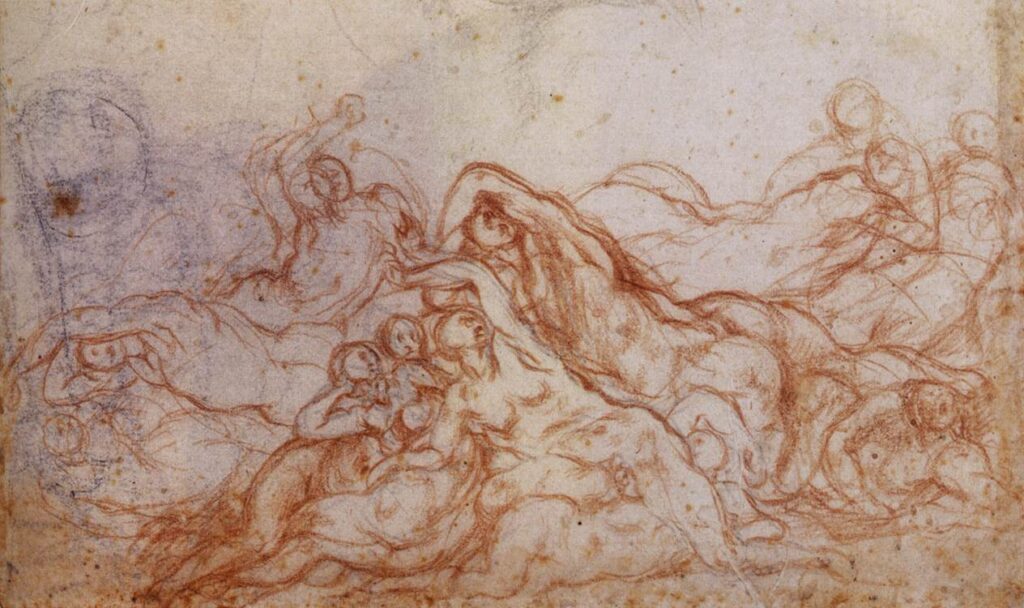
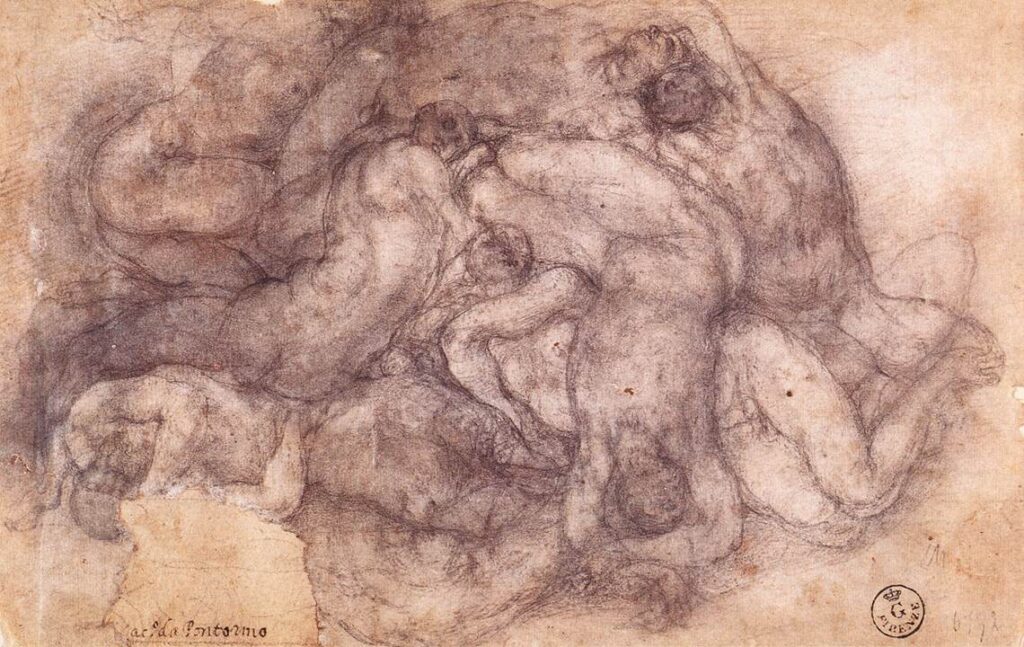
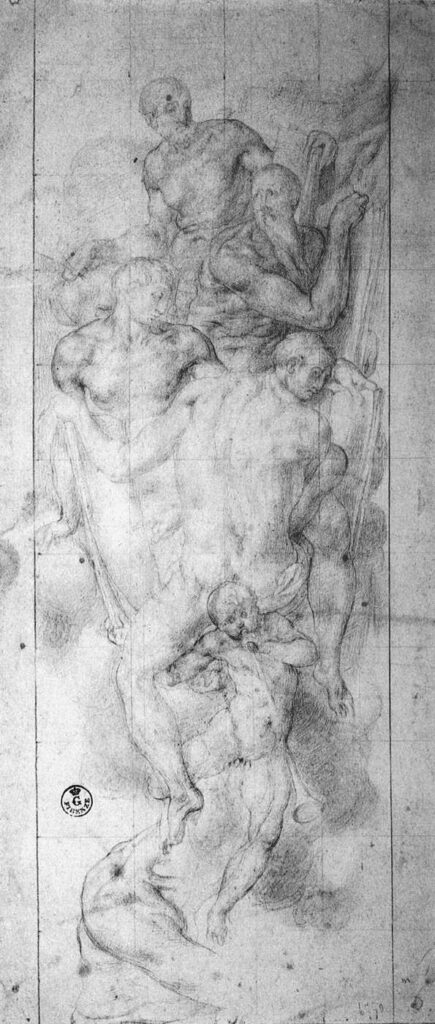
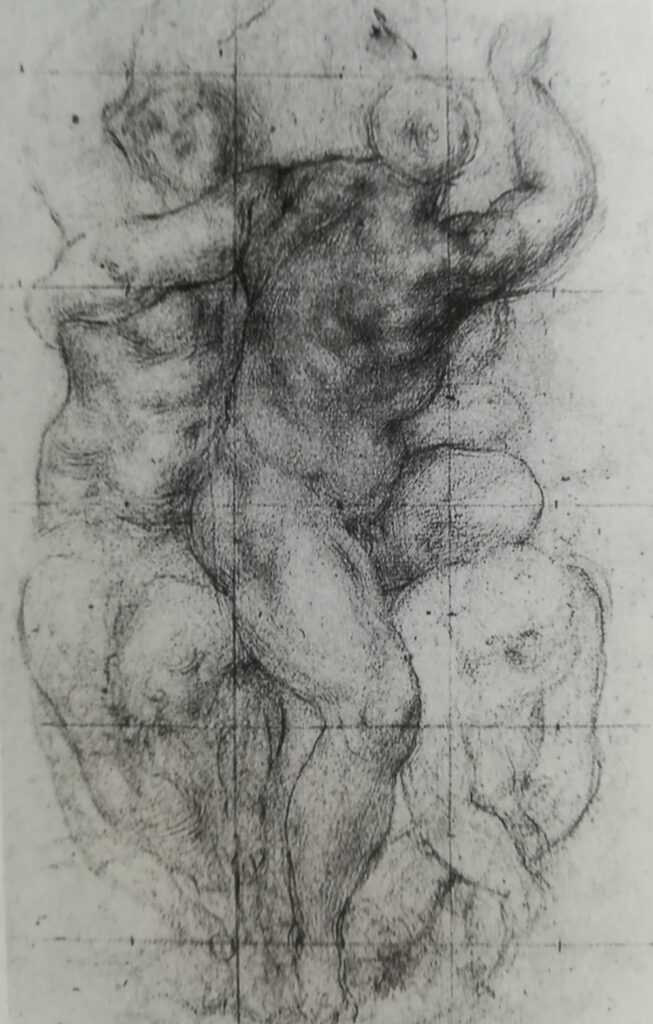
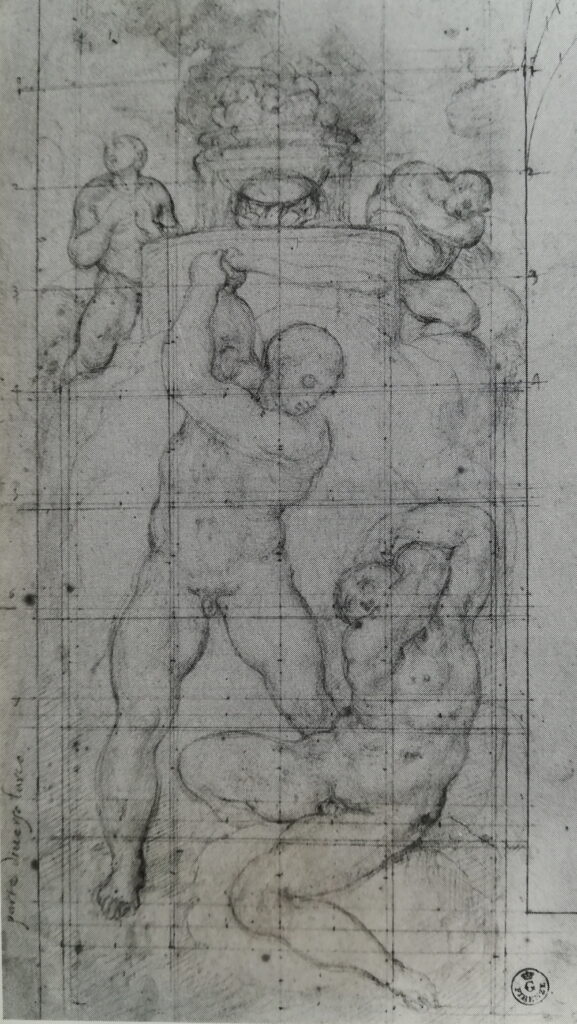
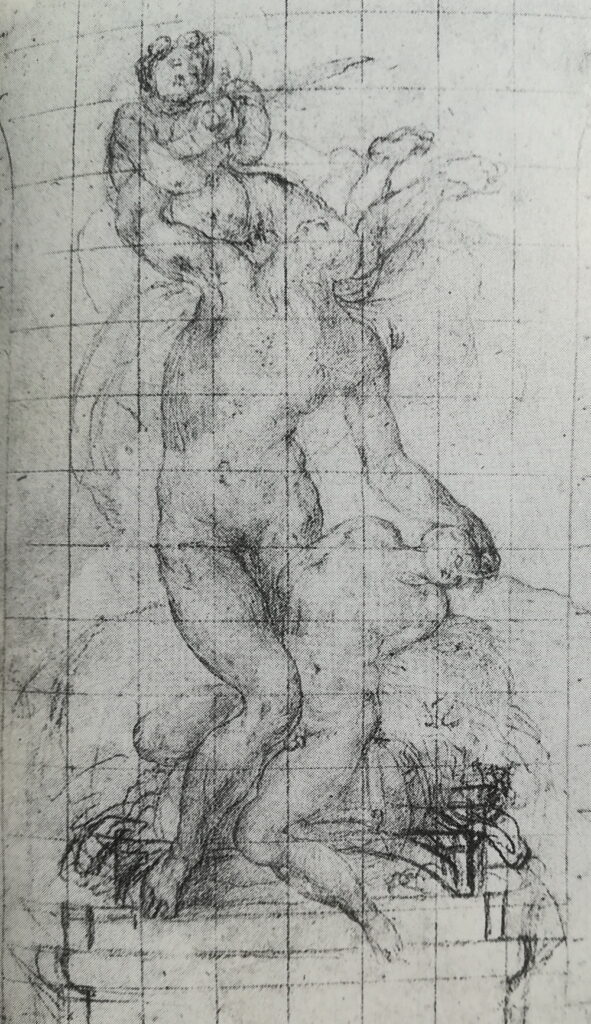
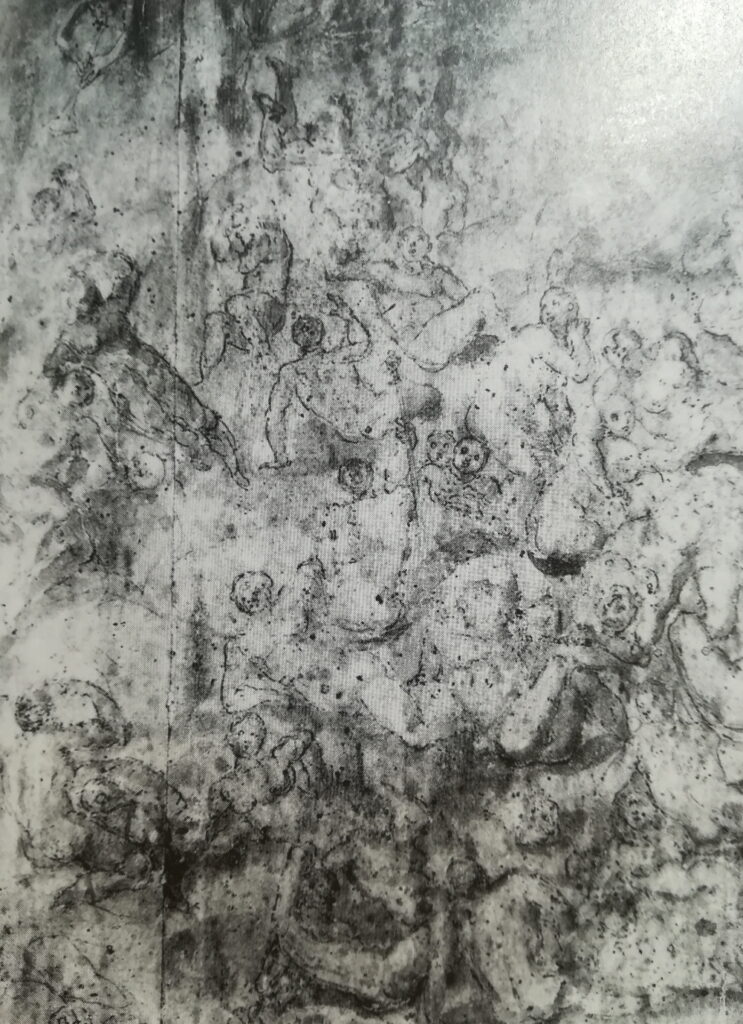
Jacopo performs the usual turata, the total and hermetic covering of the working surfaces20, it was closed for eleven years and he remained there until the day of his death on January 1st 1557 without finishing the work. At Jacopo’s explicit request, his lifelong friend Bronzino completed the work.
When, on 23 July 1558, the frescoes were finally unveiled, reactions were immediately conflicting, as Lapini reports in his Diario Fiorentino (“there were those who liked it and those who did not“). From the beginning, objections of a purely aesthetic nature were accompanied by those, more worrying, of a religious nature. While Borghini, in addition to a resentful censure of the lack of respect for the biblical “script”, points his finger, and he will certainly not be the only one, both at the scandal of the nudes (“he has made a great mass of bodies, a dirty thing to see, where some show that they are resurrected, others are resurrecting and others are dead in unholy attitudes“) as well as on the pictorial style (“and above he has made some puppets with very strenuous gestures“), Bandinelli, who also because of his unhappy background first with the Hercules and Cacus of Piazza della Signoria and then with the choir of the cathedral must have known well the weight of certain judgments, comes to write that the work had “corrupted the holiness of that church”.
The most contemptuous judgment, however, remains that of the ubiquitous Vasari:
“[…] It does not seem to me, indeed in no place, complied with neither narrative order, nor measure, nor time, nor variety of persons nor of color of flesh, and in short not any rule, nor proportion, nor any order of perspective:but full of naked people, with an order, design, invention, composition, colouring and painting done in its own way, with so much gloom and so little pleasure for those who look at that work, that I resolve, since I do not understand it myself although I am a painter, to leave the judgement to those who will see it“
In short, he says he didn’t even understand what the frescoes were about (on the other hand, what to expect from someone who “didn’t have any stability in his brain and was always rambling on about new things“?) which, in this case and for someone with his literary and iconographic culture, is rather unbelievable. Basically, the cycle would be the work of a madman who locked himself inside his scaffolding for eleven years without anyone knowing what he was doing.
If anyone among the readers was wondering “Is that possible?”, the answer is no. What should be painted on the walls of the choir had been decided even before Pontormo began to mix colors by the intellectuals trusted by Cosimo, who was always very aware of his commissions and it seems at least unlikely that he would have given free rein to anyone in the choir of his family shrine.
The crux of the matter lies elsewhere: the problem is much more theological than stylistic and understanding the reason is not so complicated if you look at the drawings and, above all, if you carefully read Vasari’s words:
“But I have never been able to understand the meaning of this story, although I know that Iacopo had wit and attended learned and literate people, that is, what he wanted to mean in that part where Christ is on top who raises the dead and under the feet has God the father who creates Adam and Eve.“
A Christ in glory who towers over the Father which, if connected to Bandinelli’s judgment above and to others of the same period, helps to shed some light.
The Lutheran Reformation, although in various degrees and declinations, had left Italy all but immune and in the central years of the sixteenth century in various ecclesiastical and intellectual circles the influence of the movement of the “Spirituali” inspired first by the preaching of Juan de Valdés and then by the Trattato Utilissimo del Beneficio di Giesu Christo Crocifisso verso i christiani, commonly called Beneficio di Cristo, by Benedetto Fontanini, had become particularly intense. The spiritual doctrine, massively influenced by the Protestant Reformation although diverging from it in some key points, did not aim at the destruction of the Roman Catholic Church but at its radical reform focused on the complete devaluation of rites and hierarchies in favor of a more intimate and heartfelt relationship with the figure of Christ the Savior and of his grace, which, descending on sinners in the form of interior illumination by divine grace, made any works and mediations irrelevant.
Apart from the front ranks made up of important figures of the religious scene such as Reginald Pole, Gasparo Contarini, Giovanni Morone, Pietro Carnesecchi or Bernardino Ochino, the movement could count on varying degrees of sympathy within several Italian courts depending on the political distance or proximity to the Roman Curia. From this point of view, the Florentine court of Cosimo was no exception. Openly sided with the imperial faction, it welcomed and protected religious, intellectuals and other outcasts who wanted to escape the unwelcome attentions of the Inquisition. It was in this environment that a branch of the spiritual movement was born among the academics, which would have among its most active members Benedetto Varchi, that is, the most likely “chief editor” of the iconographies of San Lorenzo, whose “Sermon read at the cross” on Good Friday 1549 deals with explicitly heterodox subjects.
The fact that in 1545 the Duke, for prevalently political reasons, looked favorably on a work that turned decisively towards heresy is not so surprising. But this state of affairs was destined to change dramatically. With the conquest of Siena in 1555, Cosimo’s ducal title was no longer enough and he aspired to become a real sovereign. When, in spite of the repeated attempts, he understands that his ambitions would not have obtained satisfaction from the Empire, with a remarkable diplomatic spin he begins to weave contacts with the papal court but it will be only with Pio V, about ten years later, that he will finally succeed in the intent and he will be crowned Grand Duke.
Clearly the maneuver of approach to Rome will have a price and a substantial part of it will be the request for a decisive crackdown on spiritual dissent within the territories and the court itself. If in 1567 a leading exponent such as Carnesecchi, always protected by the Medici, was betrayed and condemned to be burned at the stake by handing him over to the Inquisition, it is not difficult to understand why in the second edition of the Lives (1568) Vasari, by then more than committed to Cosimo, was concerned with devaluing and belittling the final work of Pontormo, attributing it to his lack of “firmness of mind” rather than to precise instructions from the patrons.
We have no proof of Jacopo’s possible adhesion to spiritual doctrine. What seems certain is that he knew the theme, even if only because he had heard about it from the company he attended21 but certain statements in Florence at the time, at least until Cosimo’s “turning point”, must have been rather common, if only due to fashion or conformity to the anti-Roman atmosphere of the court.
From the point of view of an artist we cannot ignore the possibility that the Reformation wes seen as simply a wave of novelty and nonconformity, a passing suggestion but useful as a catalyst to open a figurative crisis that gave life to new and unexpected iconographic and content scenarios.
From a stylistic point of view, what remains for us to judge are the splendid preparatory drawings. What emerges from those sheets is a distorted and upset Michelangelo, reinterpreted as in a hallucination and emptied of every heroic fury. The carnage of the drowned by the Flood or of the resurrected and ascending souls is a dark and terrifying tangle that conveys a meaning as ambiguous as it is melancholic.
The beardless and unthroned Christ, the apterous angels, the systematic and muscular use of the nude cannot help but make one think of the Sistine Judgement, another work considered quite borderline with respect to Catholic orthodoxy (that Buonarroti was a “spiritual” is certain), but if in the Sistine Chapel a minimum amount of doctrine was respected with the presence of a hell and some saints, in San Lorenzo Pontormo clearly severed even that timid link22 and delivered to the world a work already condemned at its appearance and which unfortunately would not have a long life.
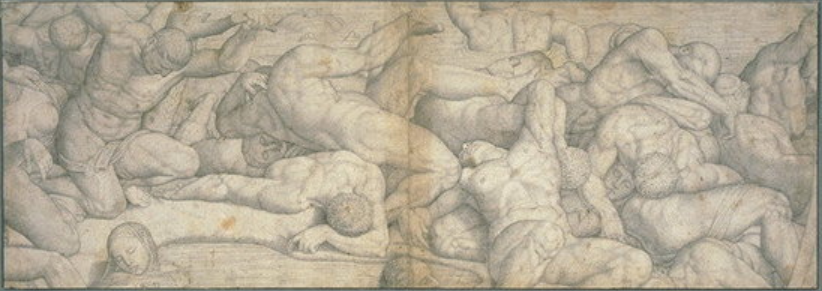
The sad destiny of Pontormo’s frescoes is closely linked to the structural restoration work carried out on the basilica in the 18th century at the behest of Princess Anna Maria Luisa, the last Medici of the Grand Ducal branch.
The first plan, much more ambitious, foresaw the construction of a bell tower, the decoration of the dome, the facade and the completion of the Chapel of the Princes, but the scarcity of funds and the advanced age of the patron (who died in 1743) only allowed a partial execution.
In the Report of 1741 the court architect Ferdinando Ruggieri had described the degradation of some parts of the basilica and tried to justify the radical structural alterations necessary to ensure the survival of the church. For the part that we are interested in, that is the choir, the report reads:
“Although for a long time the building of the illustrious Collegiate Church of S. Lorenzo had in some areas shown manifest signs of weakness, not without the threat of ruin, it was, however, much older than this was the evil hidden from our eyes by the various repairs which had been made both before Jacopo da Pontormo painted the choir, where 1/3rd of an arm and where 1/4th and 1/6th to reduce the walls to a solid state, and after the paintings had been done, the last of which had been covered by another brush.
What appeared to the eyes of everyone was to be seen in the Choir of this Church, and in the adjoining Chapel of the Rondinelli, broken in several places, and noticeably off plumb, the lintel, and the frame, which rests above the Corinthian pillars; the walls of the Choir also came off plumb.“
The surfaces frescoed by Jacopo were already unstable and muddled when he began to work on them, and the two centuries gone by had certainly not improved their health. According to Ruggeri, the origin of the problem was in the foundations. In October 1738 the walls, which were about forty centimeters off plumb, were propped up and the work was started. Since Ruggeri’s solution included two lightening arches, the entire surface below the architrave, the one with the scenes of the Flood and the Resurrection, was demolished and rebuilt.
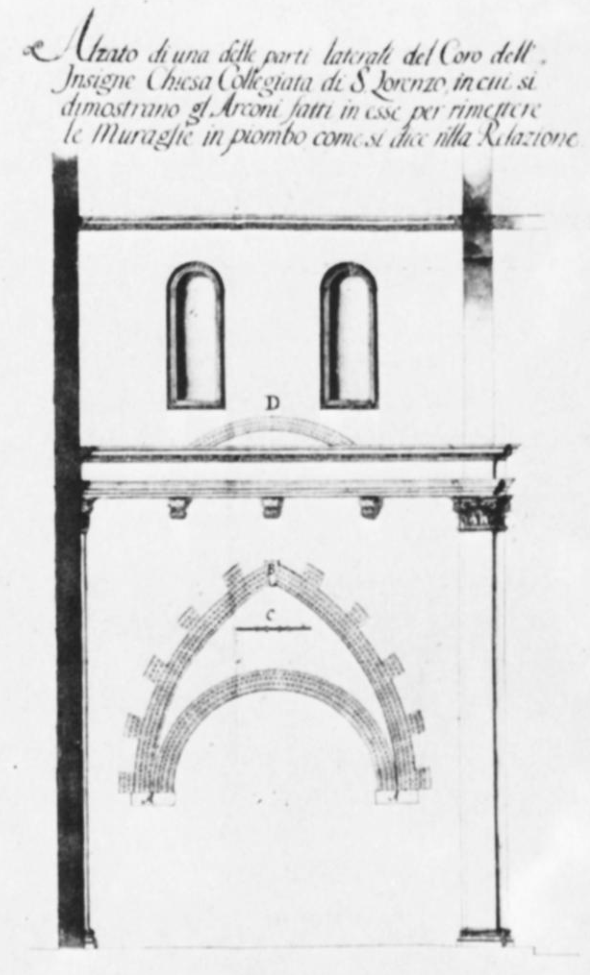
Ruggeri never mentions the destruction of the frescoes, but from the extent of the intervention it is clear that it was implicitly foreseen.
On October 16 the Canon Gualtieri recorded “The great painting by Andrea [sic] da Pontormo went up in smoke“, while Gabburri in his contemporary Vita di Pontormo affirmed that the choir “was flung to the ground“.
The measurements reported in the Report let us hope that at least the highest part of the upper part of the frescoes had remained intact but a century later the back wall was completely demolished in a failed attempt to connect the choir to the Chapel of the Princes.
The chronicle of an anonymous monk who had witnessed a conversation between the Princess and the prior of San Lorenzo, referring to the disappeared figures, reports the phrase “for being quite impudent, they did not seem to be properly from a church” while Giuseppe Richa in 1757 affirms that the loss of the frescoes “is not to be mourned“. The only voice of the time in favour of Pontormo’s work is the one of the already mentioned canon Gualtieri who defines it “one of the beauties of Florence” but it is a mere drop in a sea of annoyance or indifference.
Bigot and a bigot’s daughter23 the Princess even had to feel a certain relief in ridding herself of that unfathomable carnage in the odor of heresy and in doing so, moreover, with her back protected by Vasari’s judgment, an almost unbeatable alibi at the time, depriving us forever of what could have been the Last Judgment of Florence and that instead fell victim to those who could not and would not understand it.
In the same years in which Pontormo was consuming himself on the scaffolding of San Lorenzo, the old Buonarroti was working on his last sculptural group today known as the Rondanini Pietà: a Madonna that seems to be barely supporting a naked, inert, emaciated and lengthened Christ like some of the figures that Jacopo had loved so much and for which he had been accused of wanting to “strain nature”. I’m pretty sure he would have liked that.
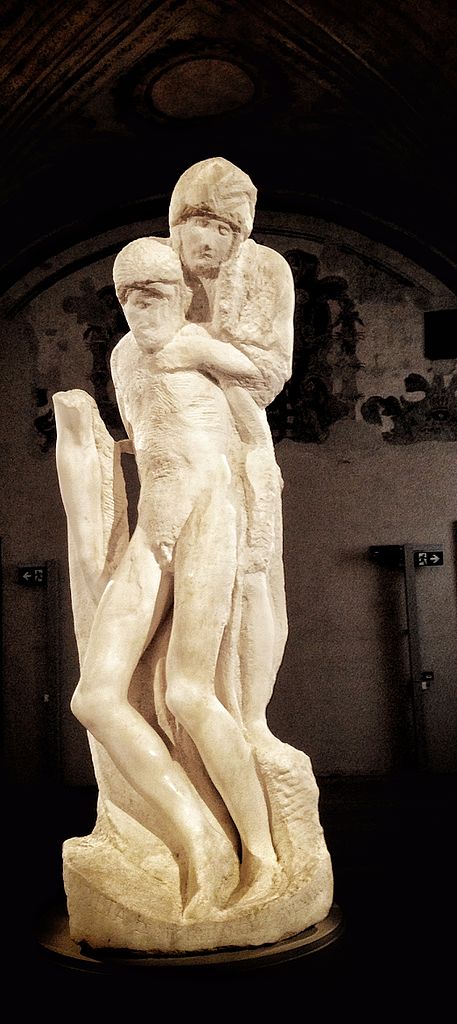
- an institution that administered the goods received by inheritance from someone considered temporarily or definitively not self-sufficient by law, such as orphans, incapacitated children, deaf-mutes, exiles, etc
- “he was put by Bernardo Vettori to stay with Lionardo da Vinci, and shortly after with Mariotto Albertinelli, with Piero di Cosimo, and finally, in the year 1512, with Andrea del Sarto“
- He was already permanently employed in the workshop of Andrea at least from 1511-12. Of his hand, besides not always marginal interventions in works of the master, would be a panel painted for an allegorical float of the carnival 1513 (Berenson B., Italian Pictures of the Reinaissance: Florentine School, Phaidon, Londra 1963, p. 221; Davidson Reid J.-Rohmann C., The Oxford Guide to Classical Mythology in the Arts, 1300-1990, New York-Oxford 1993, I, p. 326)
- see the Pitti altarpiece, also rich of Raphaelesque influences
- According to Berti (1983 p. 51) we can assume a Roman stay of the master accompanied by the two young pupils in 1511
- A small curiosity: the child sitting at the bottom of the stairs, holding a basket, is his young and beloved pupil Bronzino, already part of his workshop, curiously overlooked by another boy with reddish hair (like that of Jacopo himself) who seems to dominate him
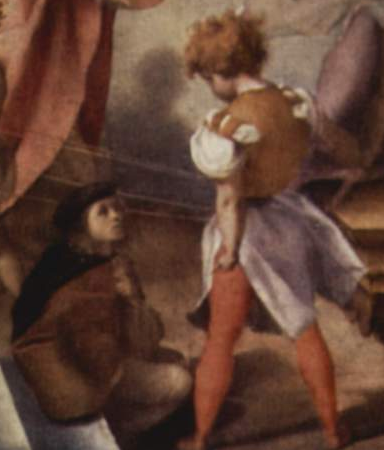
- To give an account of how much the two ideas were already perceived as radically antithetical just to remember that around the middle of the century, at the first anti-Mannerist reaction, Raphael will be used precisely in this key against Buonarroti
- Pontormo’s graphic corpus is one of the most complete left and amounts to about four hundred pieces, about half of which are preserved in the Department of Prints and Drawings at the Uffizi Gallery
- and probably it constitutes the first meeting, even if intermediated, between Michelangelo and Vittoria that later will develop a relationship of intense friendship
- The original is in a private collection in Lombardy
- “Seeing, then, how much esteem Michelangelo had for Pontormo, and how carefully Pontormo led to perfection and excellently turned to painting Michelangelo’s drawings; Bartolomeo Bettini insisted so much that Buonarroti, his great friend, made him a sketch of a naked Venus with a Cupid kissing her, to make Pontormo paint it” (Vasari, Lives)
- As even a fervent anti-Michelangelist such as Pietro Aretino could not fail to notice, misinterpreting the reasons for this (in my opinion): “…because such a woman spreads her powers in the desire of the two sexes, the prudent man has made male muscles in the body of a woman, so that she is moved by virile and feminine desires” (Letter to Guidobaldo Rovere, 1542)
- Venus and Cupid too will end up to the Medici family: the work, in fact, will never arrive in the hands of the commissioner, since as soon as it was finished it was actually seized by emissaries of Duke Alessandro, partly because of its value and partly to humiliate Bettini, a fervent republican like his friend Michelangelo, who, in fact, will complain vividly to Pontormo about what happened, hearing that he could not have opposed it since he was practically forced.
- Saturn, Mars and Mercury in the same position in three moments of the Duke’s life: birth, settlement and eighteenth birthday
- literally “butler” but the position then had a very different meaning than it does today
- born Francesco de Rossi, the surname Salviati was taken from Cardinal Giovanni Salviati, his patron in his Roman years
- In 1539 he is newly in Florence where he collaborates to the preparation of the ephemeral apparatuses for the marriage of Cosimo I with Eleanor of Toledo after which he leaves again and works around Italy
- For other unique and eloquent exception to the rule that Vasari had apparently established to include only the biographies of deceased artists
- Just as it did for the coeval choir of Santa Maria del Fiore by Baccio Bandinelli, which curiously lived a sort of parallel destiny, being first harshly criticized and then almost completely dismantled
- “Having therefore with walls, planks and curtains closed that chapel and totally given himself to the solitude, he kept it for eleven years in such a way that no living soul, neither friends nor to anyone else, ever entered it“
- The aforementioned Riccio, the Duke’s administrative right-hand man, was the owner of the only manuscript copy of the Beneficio di Cristo of which we have any information
- with the exception of an obligatory San Lorenzo painted, however, so in the bottom that it probably turned out to be covered by the high altar
- His father, Cosimo III, had Michelangelo’s nudes covered in the Sacrestia Nuova and dismantled Bandinelli’s Adam and Eve from the cathedral for the same reason (not to mention the Bureau of Public Decency, forerunner of the various moral police forces scattered throughout the world)
